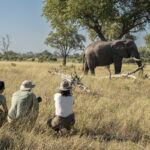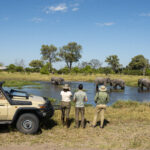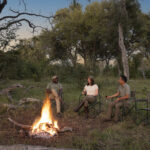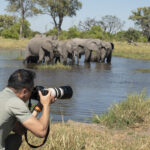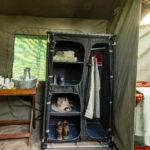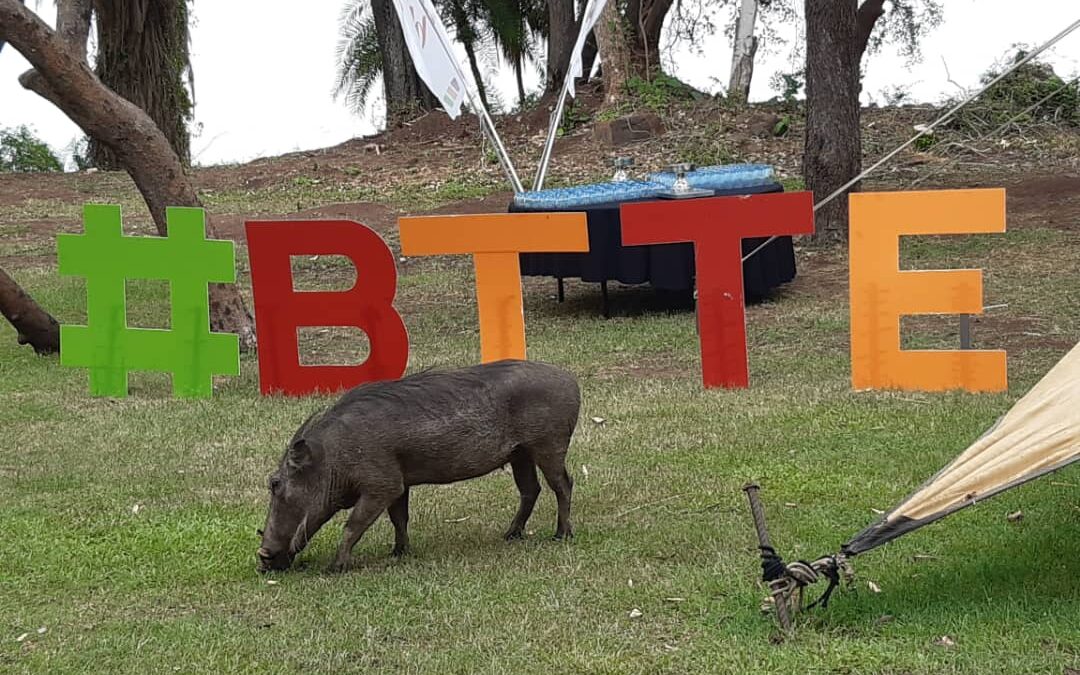
Dec 8, 2019 | Behind the Scenes, Botswana News, Brave Africa Safari, Conservation
The past two months have been hectic at Brave Africa safari. After our first official safari launch in September, our team hasn’t had a moment to relax. Instead, we’ve focused on building deeper relationships throughout the safari and travel industry, including attending BTTE (Botswana Travel & Tourism Expo).
The great news is that we have an incredible team of individuals who have worked tirelessly to make this possible. They’ve given 1000% of themselves to meet new people, rekindle existing relationships, and introduce Brave Africa as the new ultra-luxury mobile safari to book in 2020 and beyond.
Here’s a little bit about what we’ve been up to during this exciting time behind the scenes with Brave Africa safari.
Giving Back to the Community
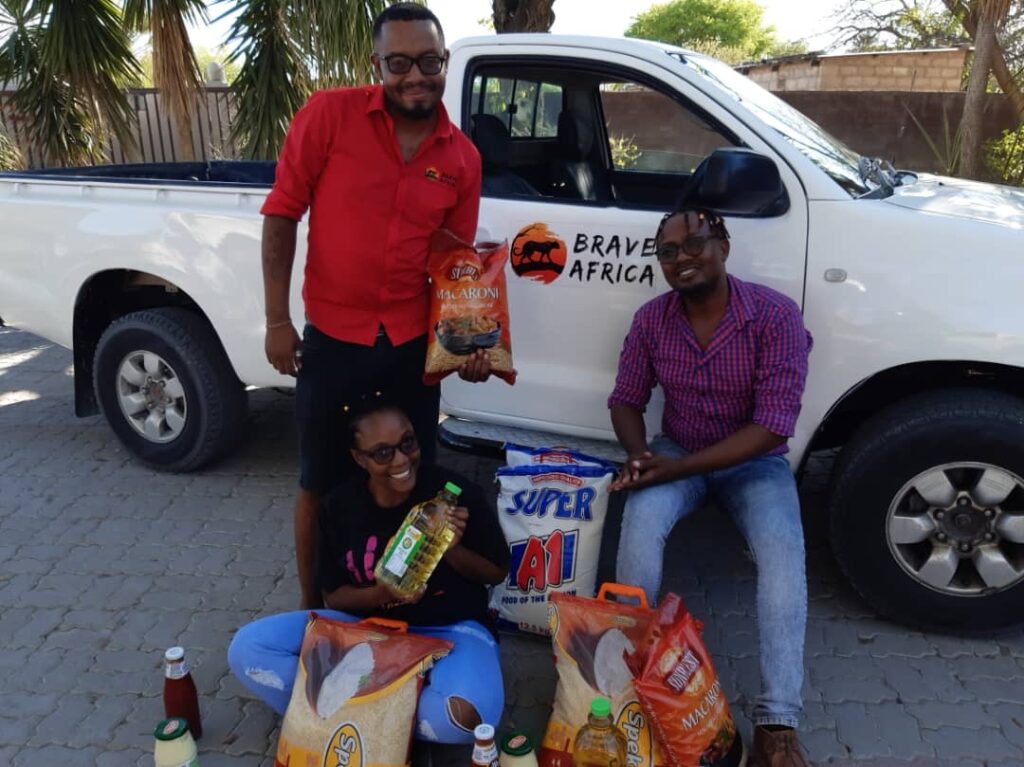
Brave Africa’s guides, Wina and Moses, dropping off food items to Safari Destinations.
In November, we had the opportunity to start giving back to the Botswana community. This is a huge piece of who we are and what we believe in. We do not want to be just another safari focused on making money and moving tourists in and out of the country. We want to make a difference not only for the wildlife but also for the Botswanan people.
We plan to do this moving forward by donating $5 a day from every guest’s trip with us to various conservation and community charities. Our team is currently doing extensive research to find the best non-profits to give to, and we’ll have that list available soon. However, we already had the opportunity to help the elderly population in Maun, and we’re so glad we got to participate.
Safari Destinations, one of Botswana’s premier travel agencies, held an annual charity drive to collect needed items for older individuals within the Maun community who require assistance. Our team got together and purchased massive bags of food goods to do our part.
For our Brave Africa safari staff—all of whom are Botswanan natives—taking care of your elders is the responsibility of the community. They shared with us funny stories of being kids and being charged with walking to the store for an elder to purchase their groceries, whether they were related to the individual or knew the individual well or not. Participating in this charity event made a lot of sense and was special to our team.
A Trip to Victoria Falls

Tabona Wina (left) and Moses Teko (right)
The following week in November, our team headed up to Zimbabwe and Victoria Falls to meet with travel agencies throughout the area and start building relationships. This trip was made possible thanks to Shelley Cox at Africa Conservation Travel.
Africa Conservation Travel is a travel agency that is focused on offering safari experiences dedicated to sustainable tourism and conservation-conscious itineraries. Their mission is to create awards about protecting and conserving the wildlife and habitats during every trip.
Shelley has been an integral piece of Brave Africa safari since the very beginning. She is a good friend of our owner, Tabona Wina, and has offered our team priceless guidance. We are beyond grateful to her and her company.
Thanks to Shelley’s connections and the hard work of our team, we were able to introduce Brave Africa to other members of the safari industry. We loved getting to share our mission and vision and to tell our story to travel agencies who will help us connect with guests who share our values from around the world.
Building this base of support is critical to our eventual success and helping safari-goers discover us.
Thank you for taking the time to meet with us!
Botswana Travel & Tourism Expo (BTTE)
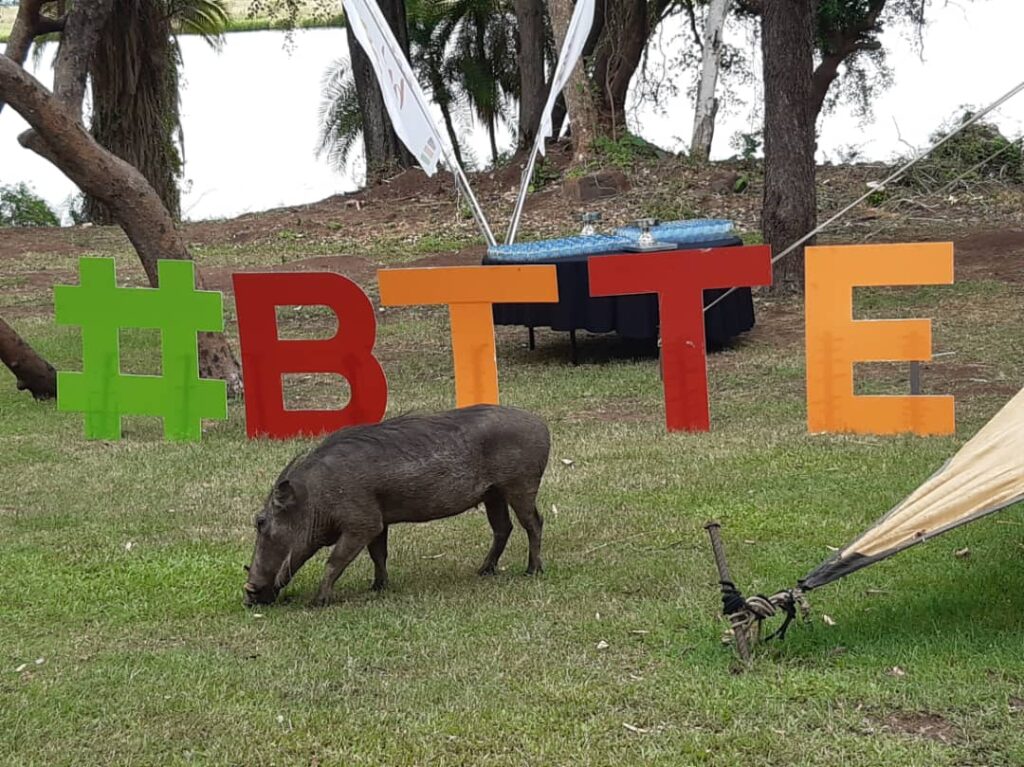
Botswana Travel & Tourism Expo
Finally, we kicked December off with a bang with Botswana’s largest travel and tourism expo: BTTE. This unique, annual event offers an opportunity for the greater European travel industry to establish relationships and business partnerships with Botswana’s tourism industry. Every safari company, travel agency, and tour operator in Botswana attends this networking event, and we were thrilled to take part!
Held December 2rd – December 6th, in Kasane, #BTTE19 was the event of the year. Over 280 exhibitors, including 140 local operators and 140 international operators from 33 countries around the world participated. Attendees came from all over, including Argentina, United Arab Emirates, Israel, and throughout Europe.

Pano of the BTTE tent
The goal of the event is to introduce the many incredible tourism opportunities available in Botswana and to demonstrate the unique manner in which the country approaches tourism. Unlike many other African countries, Botswana is dedicated to protecting the environment and the country’s natural resources as much as possible to keep tourists coming back over and over again.
For Brave Africa safari, BTTE was an opportunity to set up a booth where attendees could come up to learn more about who we are and what we offer. We also had a table for a “Business 2 Business” event where attendees had just 15 minutes to meet our team and get to know our product before they moved on. This was an inspiring, educational, and super productive session, where we established many strategic relationships.
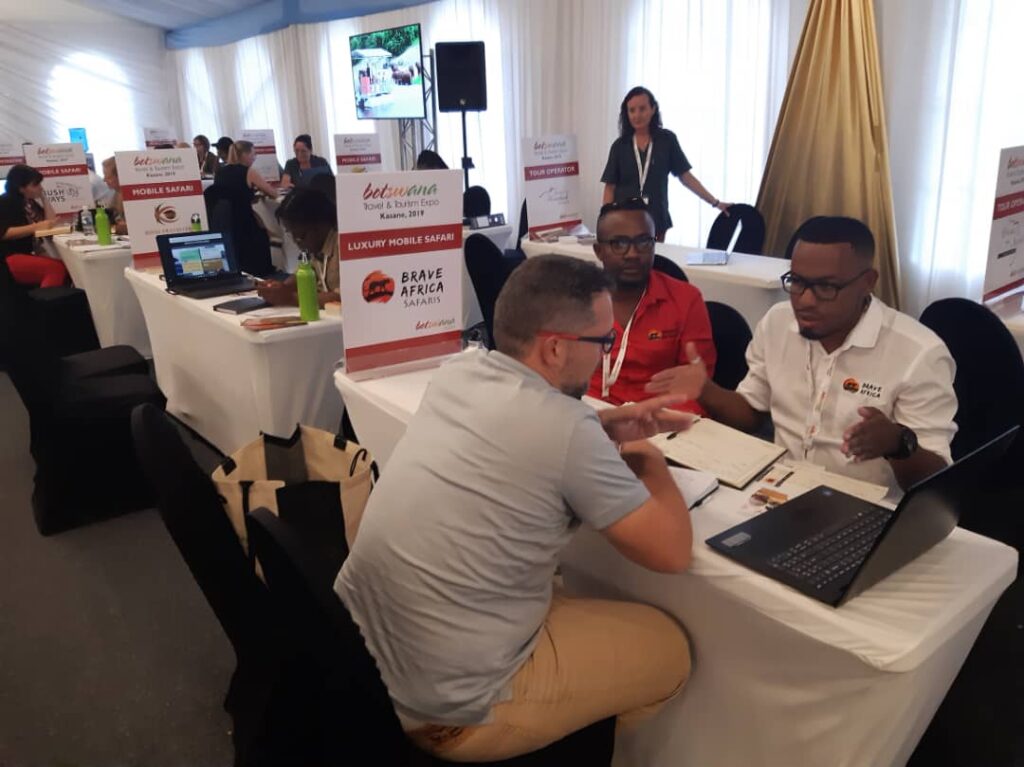
Wina & Moses during the brief Business 2 Business sessions
The week-long event included presentations from experts on the Botswana tourism industry as well as the different unique areas of Botswana. There were meet-and-greet sessions, workshops, cocktail dinners, and more. It was an exhausting week, but BTTE was a fantastic opportunity for Brave Africa to establish that we are here as part of the community and proud of it.
Next Up for Brave Africa Safari
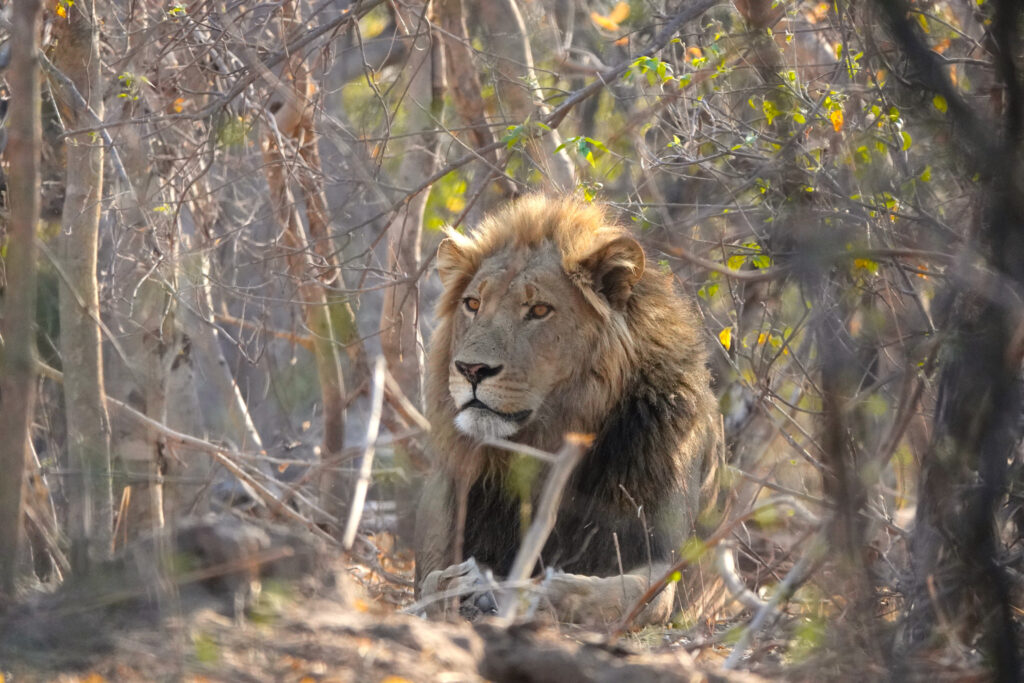
In a week, our team will be heading out into the Botswana Bush to explore a possible new Brave Africa safari itinerary—the Kalahari Desert.
This southern route will possibly be available to guests during the rainy season (December – March) when the Okavango Delta is flooded and difficult to navigate. During these months, the Kalahari is in peak season because animals are leaving the floodplains for more semi-arid regions.
December and January mark the great zebra migration in the Kalahari as well as the flamingo migration in Makgadikgadi Pan. This area is also known for its beautiful black-maned lions, brown hyena, oryx/gemsbok, and more.
We’re excited to test out this potential route for our guests in 2020, which will include:
Stay tuned to learn about our adventure in a few weeks!
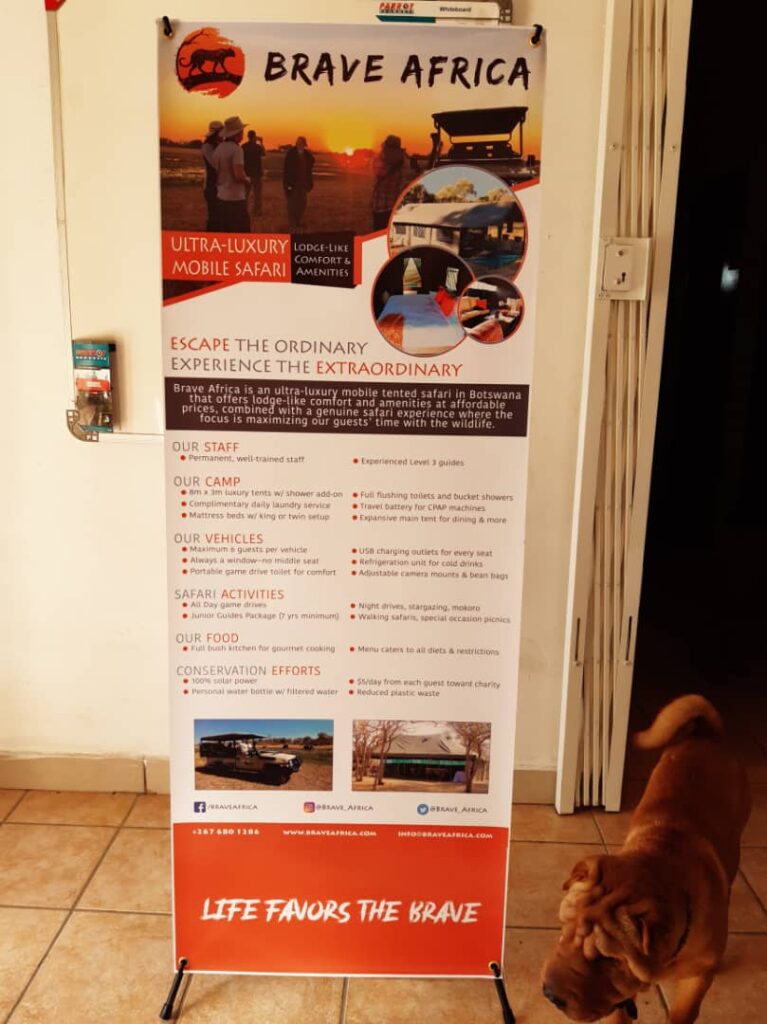
Brave Africa’s table banner
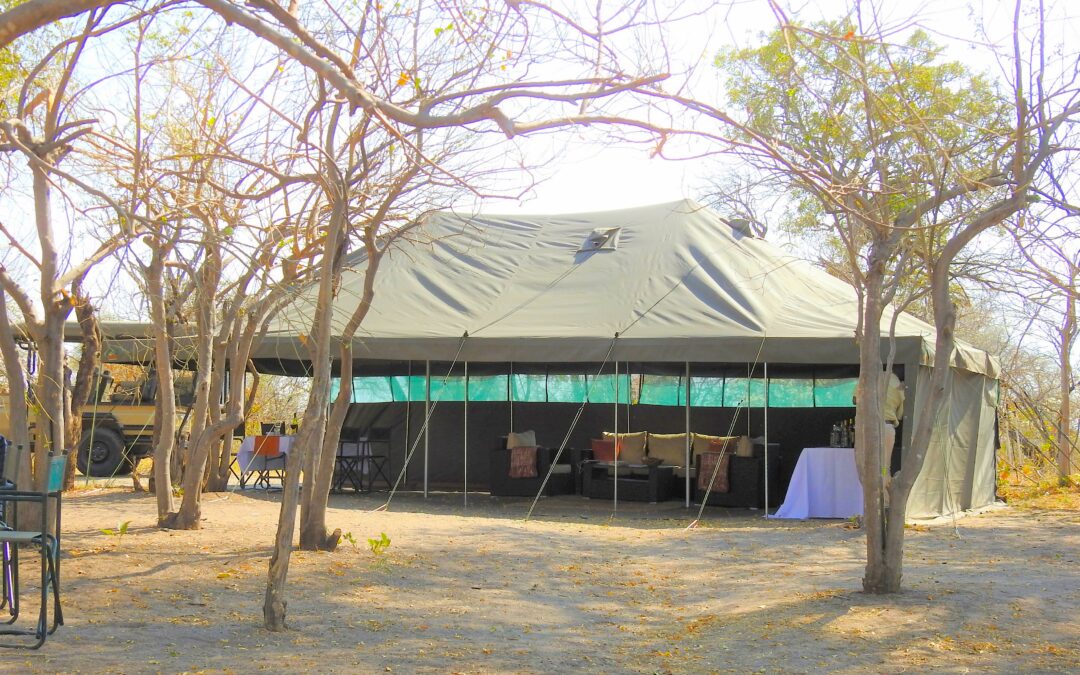
Nov 29, 2019 | Brave Africa Safari, Most Popular Blogs, Safari Tips
Before you go on a safari in Botswana, you have to do your research. Safaris are not cheap, and the last thing you want to do is try to save money and end up with a sub-par experience and a safari camp or lodge that’s far below your expectations.
The problem is that there’s both too much and too little information out there. We’ve been where you are and have spent countless hours (days!) online trying to figure out what it’s like to go on an African safari.
And trying to figure out where to stay? Forget it!
You might as well just close your eyes and pick an African safari lodge or camp at random. After all, they can’t be that different than each other. But that’s where you’re wrong.
Every Safari Accommodation is Different
While both safari lodges and safari camps offer incredible experiences and can share many of the same features, there are some major differences and similarities you need to be aware of before you make your choice. (And don’t forget to check out our similar blog about safari vehicles.)
Our goal is not to sway you toward any specific safari accommodation over another, but to provide you with an in-depth overview of your options so that you can make the best choice for you.
First, a warning…pictures are not always accurate. Some safari camps and lodges are known for photoshopping their images or putting pictures online that don’t match their typical product, but instead require hundreds or thousands of dollars in upgrades. Don’t trust what you see. Instead, be sure to do your own research and ask questions. Look for customer pictures on TripAdvisor or Google Business, or work with a travel agent who has visited the camp and can confirm that what you see is what you get.
Botswana Safari Accommodation Features
Now, before we jump into the different types of accommodations, let’s talk about a few key features of your safari vacation.
- Bedroom: Your sleeping situation can drastically change depending on your camp. Be sure to ask if you have a normal mattress bed or cots, and if the bed can be set up as a king or just two twins. Also, the size of your tent can be anything from a small dome you can’t stand inside to an extensive lodge suite and everything in between.
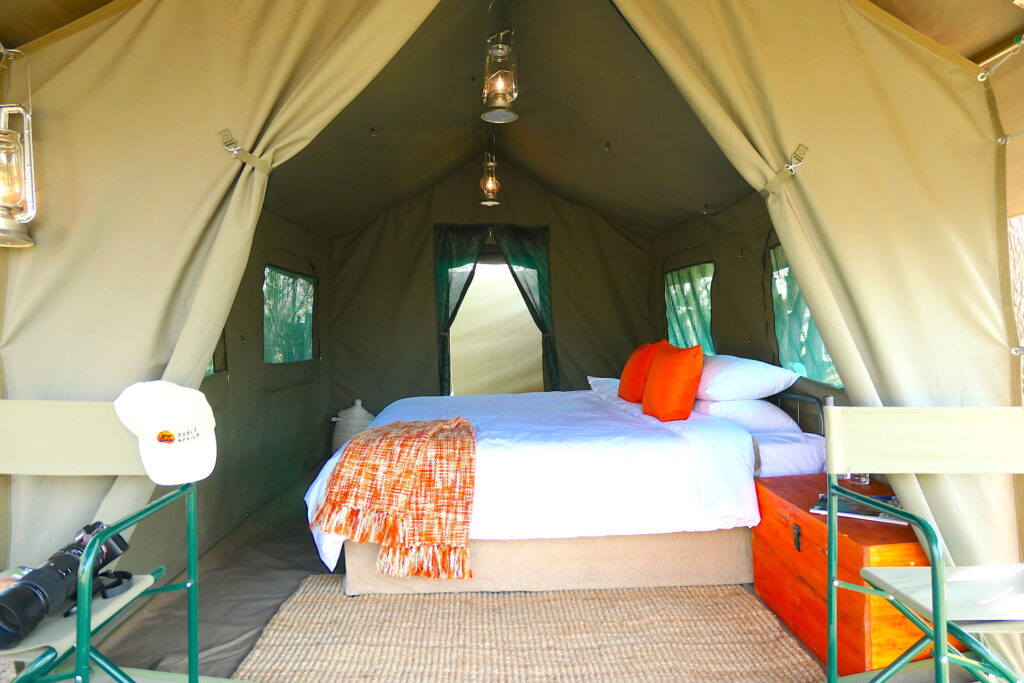
- Bathroom: Not every safari camp includes an attached toilet and bath/shower. Most safari lodges will have a flushing toilet and shower, but bucket showers are still common even in luxury lodges. For mobile camps, drop toilets are typical and showers may be communal.
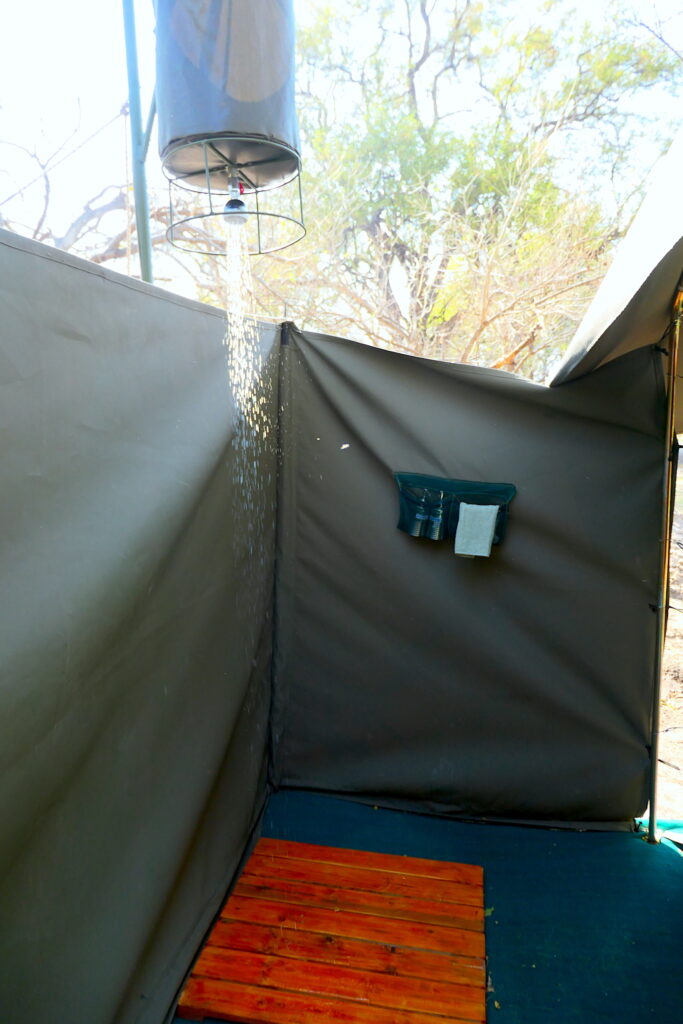
This is our custom-built shower add-on to every tent. It provides an additional 1.5 meters of space for our guests to enjoy and ensures your tent isn’t soaked during your shower.
- Shared Areas: Think of shared areas as similar to a hotel lobby or the living and dining room in your home. Every safari camp will have a campfire where you’ll hang out regularly. However, the type and size of your dining area can vary greatly, so can any sitting areas, the bar, and more. Some lodges may also have a pool.
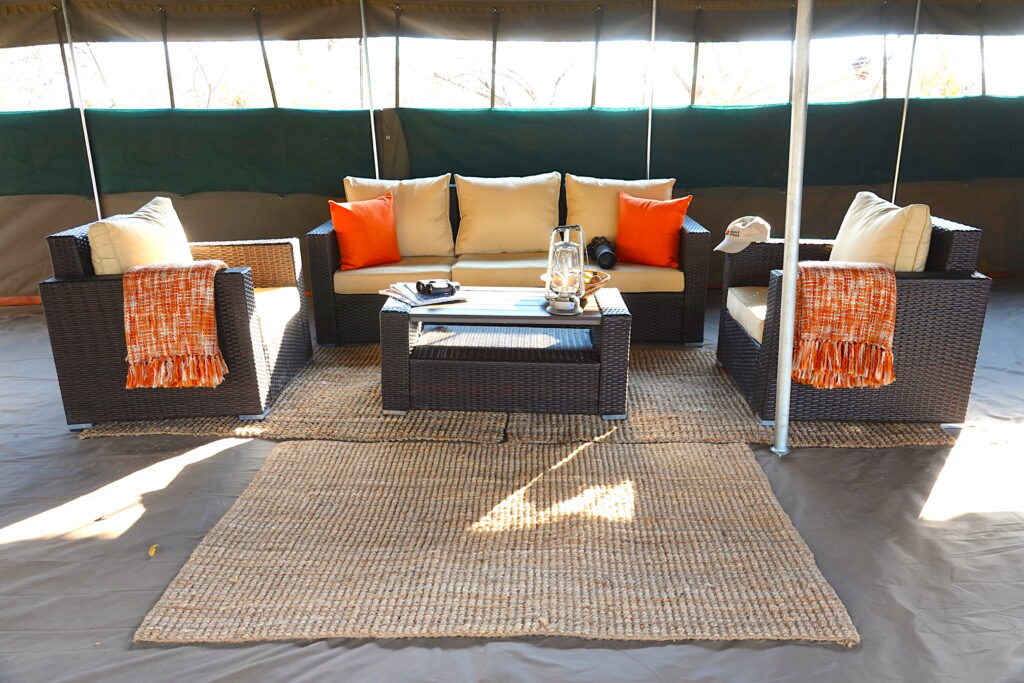
- Power Outlet: At most safari lodges and camps, all power outlets are found in the shared areas. Your room will not have the ability to charge technology. Any charging you want to do in your room will require travel batteries and some camps may only offer charging via a car battery.
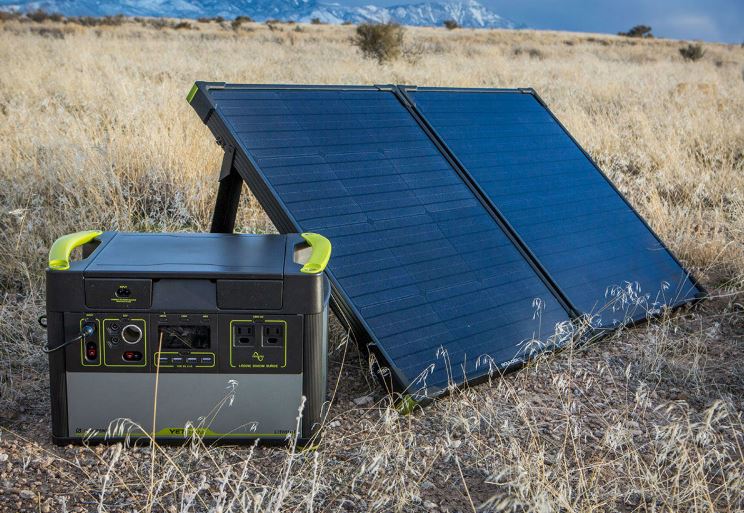
- Internet Access: Very few, if any, Botswana safari camps offer access to the internet. The goal of a safari is to unplug, so do not expect internet or mobile to work while on safari. Instead, use your safari as an opportunity to forget that the rest of the world exists. (We do have a satellite phone available for emergencies.)
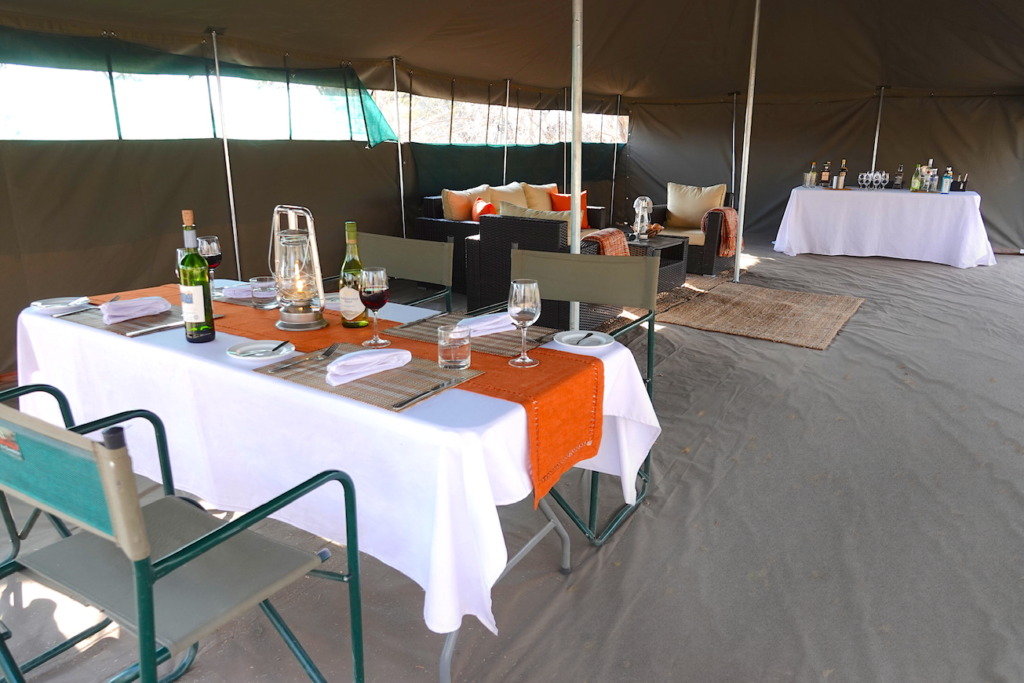
- Food: Most lodges and camps have a chef, but the type of food they serve can very. For many mobile safari camps, cooking is done over an open fire, which can drastically limit the menu. However, some mobile camps, including Brave Africa, have an entire outdoor kitchen with a full stove and oven, which means the chef can cook the same types of meals you’d find in any hotel or restaurant.
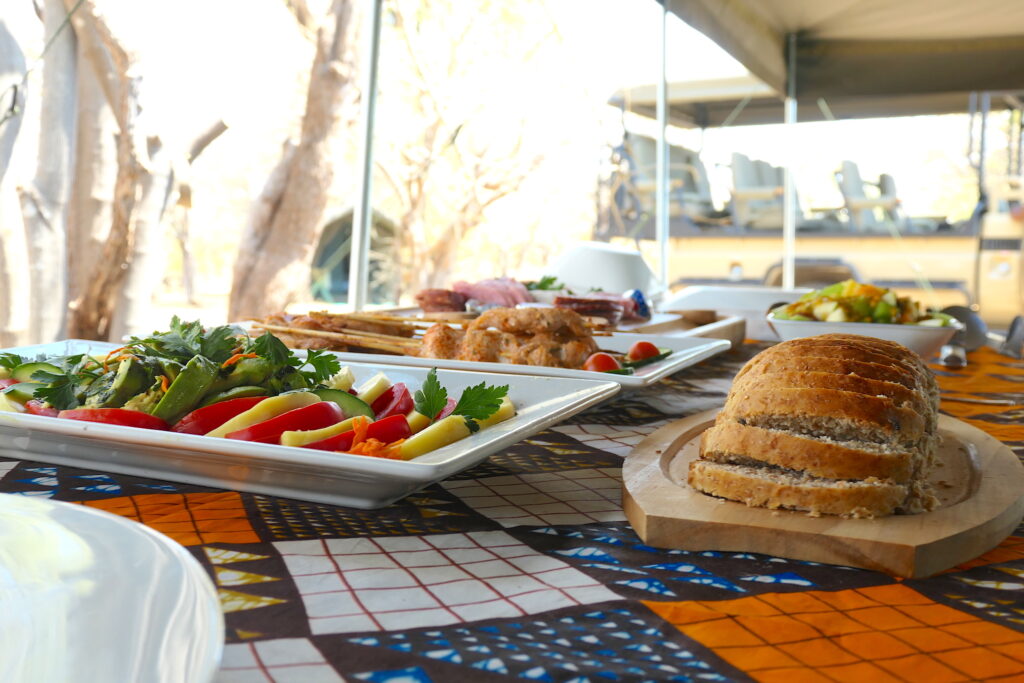
Safari Lodge vs. Safari Camp
Now, let’s look at the more specific differences between safari lodges and safari camps to help you make your final choice of accommodation. When going on safari in Botswana, you typically have three choices:
- A luxury safari lodge,
- A mobile safari camp
- A self-drive safari camp
Botswana Safari Lodge
A Botswana safari lodge is more like a luxury safari hotel. It’s a structure that remains in one location that you, as a safari guest, travel to and stay at. Typically, safari lodges will have communal areas that act like hotel lounges. There’s probably a dining hall, a reception, and a pool. Safari lodges are often built with wood, though rooms can still be canvas tents, but they offer more of a hotel-like feel. Expect:
- Suite-type rooms with comfortable beds and lots of space
- Luxury bathrooms with running water
- Large communal areas for dining and relaxing, including a pool
- Technology charging in the main communal area
- No internet access except at the more premium lodges
- Premium, chef-designed meals
All Botswana safari lodges are 100% focused on a luxury experience. They are beautifully crafted locations that are dedicated to your comfort. Guests can expect many similar features to a luxury hotel room.
Mobile Safari Camps
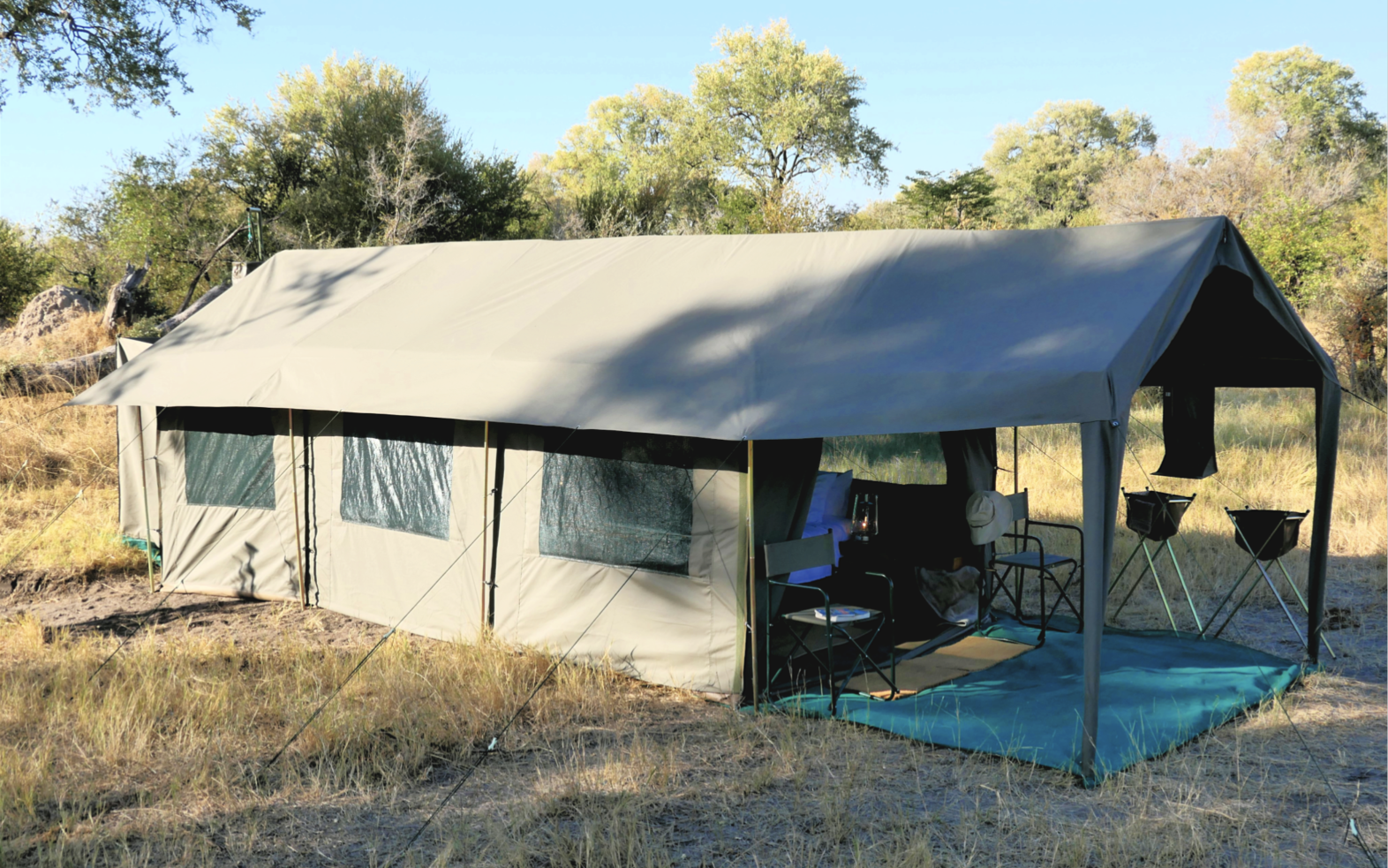
The second type of safari accommodation you’ll find in Botswana are the mobile safari camps. These can vary depending on how much you’re willing to pay and the type of experience you want. There are five types of mobile safari camps you can expect: budget, standard, premium, luxury, and ultra-luxury.
It’s important to note that the naming conventions we used above are NOT standard for the industry. Many standard camps use the phrase “luxury” to sell rooms. Before you take any naming at face value, ask about the type of experience you’re going to enjoy.
Budget Mobile Camping
With extreme budget mobile camping, your operator will provide tents, meals, and basic amenities, but the rest will be up to you. You may be expected to build your own very small dome tent or to participate in cooking. As for your sleeping and bathing arrangements, sleeping bags or cots are typical and toilets/showers might be shared.
Standard Mobile Camping
With standard mobile camping, the experience is a little more all-inclusive. You’ll still have small dome tents with limited amenities. However, the company will take care of setting up and tearing down your tent and all of the cooking. Think of this as camping with a team that takes care of the basic details. Bathing arrangements may still be shared between camp guests, though you should have your own drop toilet near your tent.
Premium Mobile Camping
Premium mobile camping will get you bigger tents with a little more room to move around. With these safari camps, you’ll have your own private toilet (drop) and bucket shower, typically connected to your tent. You still might sleep on cots, but all of your amenities are a little more premium, including your food—it will be cooked over a fire by a chef. You should also have a small dining tent that can be used as a shared communal area.
Luxury Mobile Camping
Luxury mobile camping upgrades all of your features. Your tent should be large enough for a King bed setup with extra room to move. The toilet and bathing amenities should be top-notch. You may have a flushing or a drop toilet, but the entire experience should feel much more luxurious—these experiences are often referred to as “glamping.” Meals may still be cooked over a fire, but should also include higher-quality ingredients and more variety. Communal areas tend to be on the small side, but they are comfortable though mainly used for dining.
Ultra–Luxury Mobile Camping
There are very few ultra-luxury mobile camps; Brave Africa is one. These are lodge-like camps where you shouldn’t feel as if you’re camping at all. Toilets are flushing, and tents are very spacious with comfortable mattresses, storage space, luxury amenities, and private on-demand bathing. As for the communal areas, they are much more expansive and include a seating area, room for dining, and a bar set up where guests can hang out at any time. Food should be cooked in a mobile kitchen with a full oven and stove, not over a fire, and premium alcoholic beverages are available.
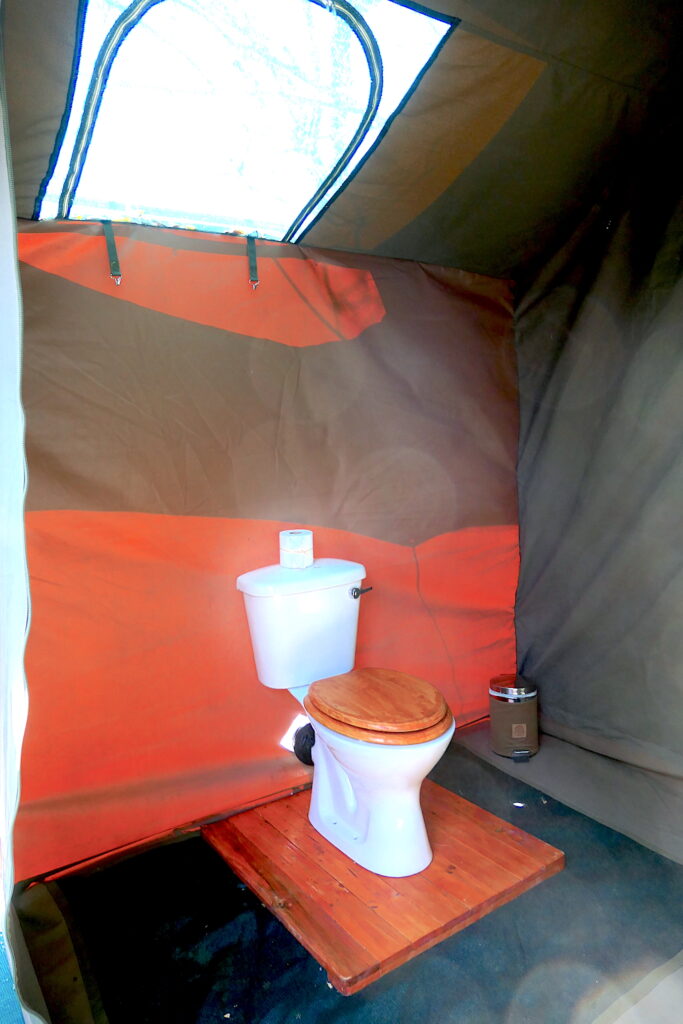
Brave Africa flushing toilet
Self-Drive Camps
Lastly, there are self-drive camps. This is camping at its most basic. You’ll have your own car, which comes with basic camping amenities. You are in charge of everything, including all supplies. You’ll be limited to campgrounds that are open to self-drive tourists and have to share communal bathing and toilets with all other self-drive guests.
Brave Africa’s Ultra-Luxury Mobile Safari Camp vs. a Safari Lodge
| Amenities |
Standard Mobile Camp |
Typical Safari Lodge |
Brave Africa Camp |
| Bed |
Cots (twin beds) |
Typical mattress bed (king or twin) |
Typical mattress bed (king or twin) |
| Tent Size |
Very small, little room to move |
Luxury suite |
Comfortable hotel-room size |
| Toilet |
Drop |
Flushing |
Flushing toilet |
| Shower |
Bucket shower (potentially communal) |
Standard hotel shower with running water |
Private bucket shower |
| Sitting area |
Captains’ chairs only |
Comfortable couches and chairs for relaxing |
Comfortable couches and chairs for relaxing |
| Dining area |
Small tent for dining or around an open fire |
Large dining room |
Large dining room |
| Pool |
No |
Yes |
No |
| Power |
Shared power in the main area, may be limited to a car battery |
Shared power in the main area typically solar-powered |
Shared power in the main area typically solar-powered |
| Internet Access |
No internet access |
No internet access in the most premium camps |
No internet access |
| Food |
Cooked over an open fire |
Chef-created in a full kitchen |
Chef-created in a full kitchen |
https://www.youtube.com/watch?v=5QOObpI95JU
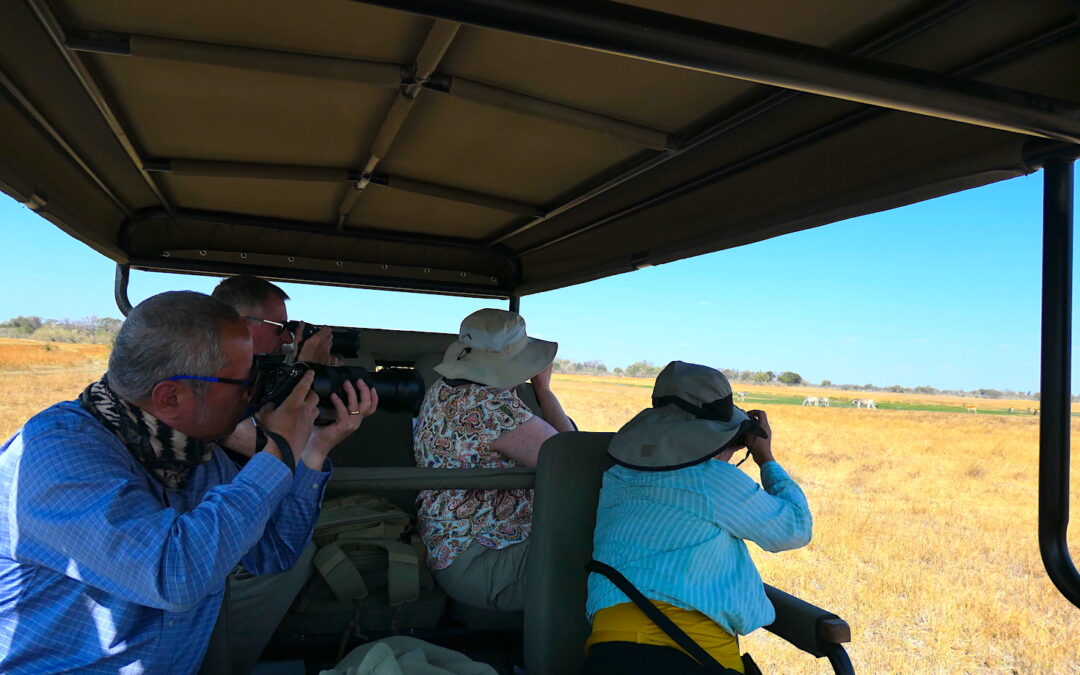
Nov 9, 2019 | Adventure Safari, Brave Africa Safari, Game Drive, Safari Tips
Safari guiding is the most critical element of a life-changing safari experience. A guide is your connection to the wildlife, your host in the Botswana bush, and your personal Wikipedia page. Without an exceptional safari guide, everything about your safari will be lackluster, and you could even put your life in danger. (more…)
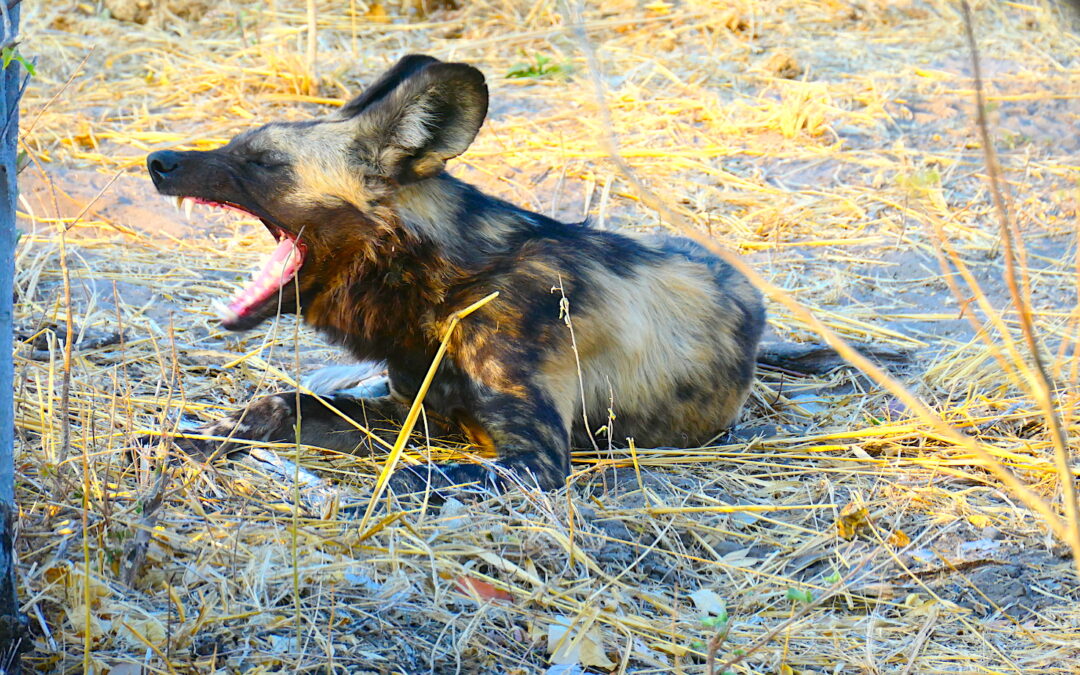
Nov 2, 2019 | Adventure Safari, Animals of Botswana, Brave Africa Safari, Game Drive
On a safari in Botswana in Brave Africa, there’s always something new to experience. We never know what we’re going to see on a game drive, but we know it’s always going to be something exciting as long as we’re open to the possibilities. This time it was a pack of wild dogs hunting.
On our most recent trip out to Xakanaxa (Moremi Game Reserve), even our staff got to join in on the excitement when at least two-dozen wild dogs, including four puppies, hunted an impala at camp.
Wild Dogs at Camp
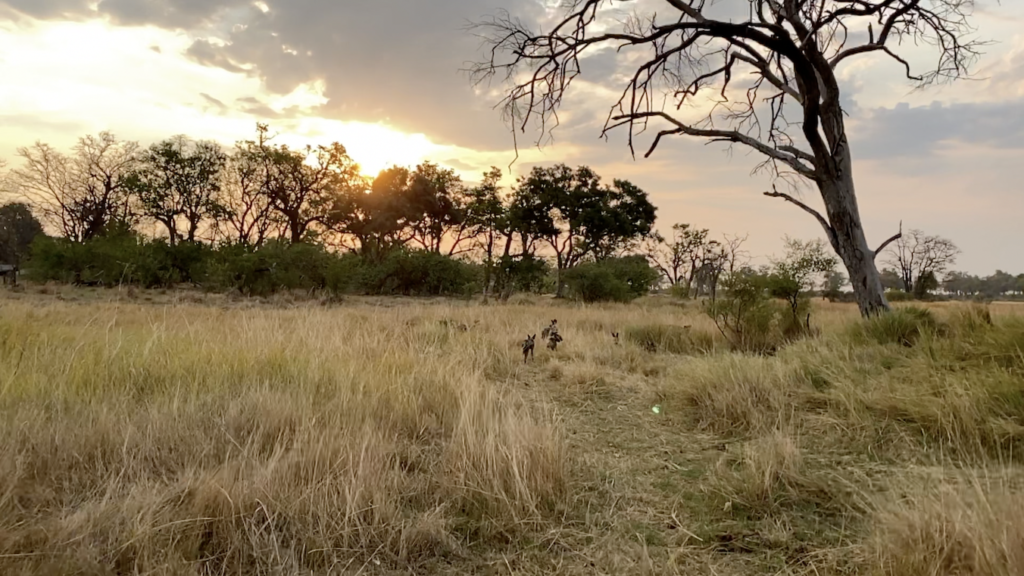
Wild dog pack of about two-dozen dogs hanging out at the Brave Africa camp in the Moremi Game Reserve.
After a wonderful all-day game drive, Wina and our guests were heading back to camp for dinner when they ran right into a huge pack of wild dogs. We were barely a hundred meters from camp. You could see the staff tents, our moving trucks, and the main tent, and yet right there in front of us, there had to be about two dozen wild dogs all walking along in the setting sun, including four puppies—around six months old.
They had just woken up from their afternoon nap and were on the hunt.
With a pack that large—more than twenty dogs—hunting enough food for everyone is a challenge. The pack has to kill multiple times a day to stay healthy, and that can be especially difficult with pups. The pups always have to be protected, but they also have to learn how to hunt, so it’s a fascinating balancing act.
When we first came upon them, the pack was slowly meandering along. They were spread out and looking for food, but nothing urgent. The pups were toward the back, bouncing along, with assigned minders to make sure they kept up and didn’t get into too much trouble. And the rest of the pack was in formation, looking for prey.
Then, between one moment and the next, everything changed.
Wild Dogs Hunt at Brave Africa
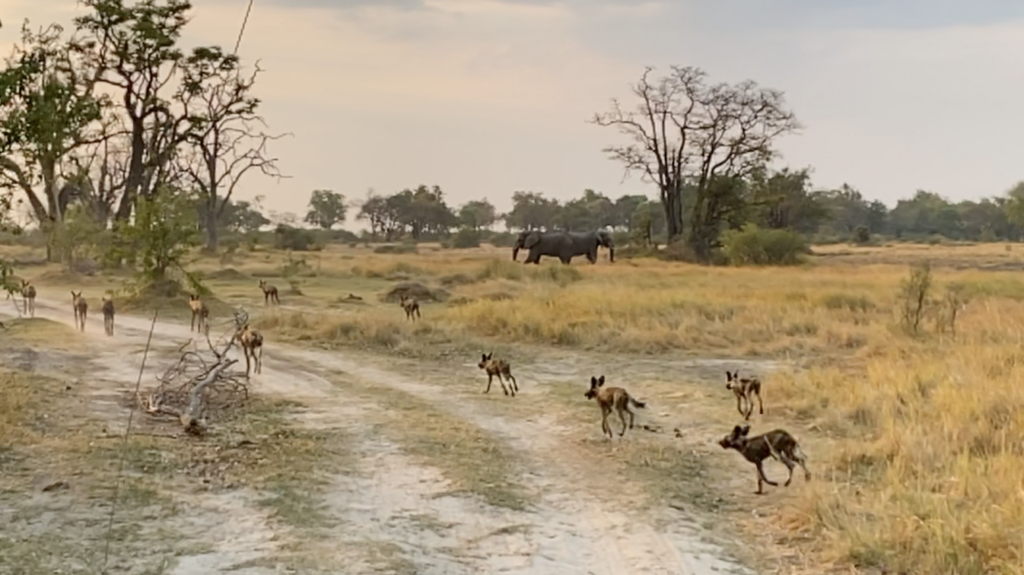
The wild dog pack prepares to hunt.
Suddenly, we heard some high-pitched squeaking. It was the dogs sending out a warning call about nearby prey. It seemed like we blinked, and then there was an impala on the move.
She was in the wrong place, at the wrong time. No lone animal would stand a chance surrounded by more than 20 hungry dogs, and neither did she. While she leaped and ran as fast as she could, she wasn’t fast enough.
The wild dogs won.
Only a few of the pack actually went to the kill site, the rest stayed back with the puppies, and so did we. The puppies didn’t have the energy to keep up with the adults on the hunt, and we didn’t have the speed, but in this case, waiting behind was not a problem.
While we didn’t witness the kill, a few minutes later, we saw something just as special.
Wild Dogs Taking Care of Puppies
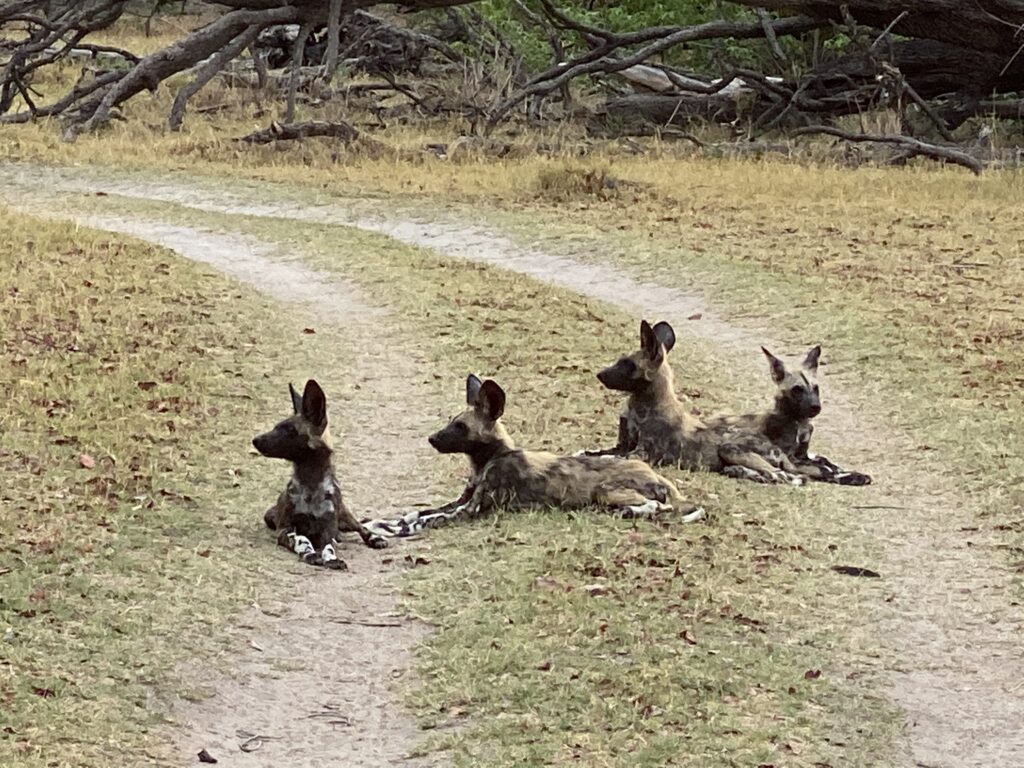
Four wild dog puppies waiting for the adults to come pack with food.
Wild dogs are incredibly social creatures. They are all about the pack. No dog is left behind, and every pup is well cared for, and we got to witness this first-hand.
Since the puppies were too young to hunt, the adults brought the kill to them. No, they didn’t drag over the kill like lions would do. They also didn’t force the puppies to move to the kill site—that would be too dangerous. Instead, the adults took turns eating and regurgitating food for the puppies.
That’s right. We got to witness wild dogs vomiting pre-chewed and swallowed food so the puppies could enjoy.
It was ADORABLE. And no, we’re not joking.
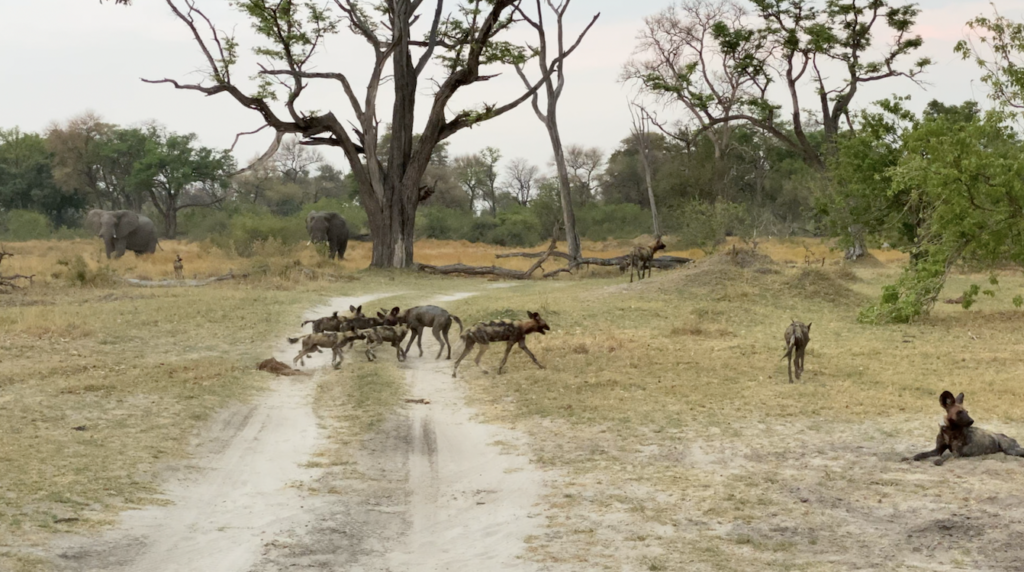
Wild dog puppies eating regurgitated impala thanks to a successful hunt.
It was astonishing to see the family dynamics. The four puppies stayed together, and every time an adult came back from the kill site, they immediately went up to the puppies and regurgitated enough for a meal.
The puppies squeaked and squealed and ate their dinner happily until the next adult would come back. They did this over and over again until the puppies were full, and the kill was demolished.
Wild Dogs and Brave Africa Staff
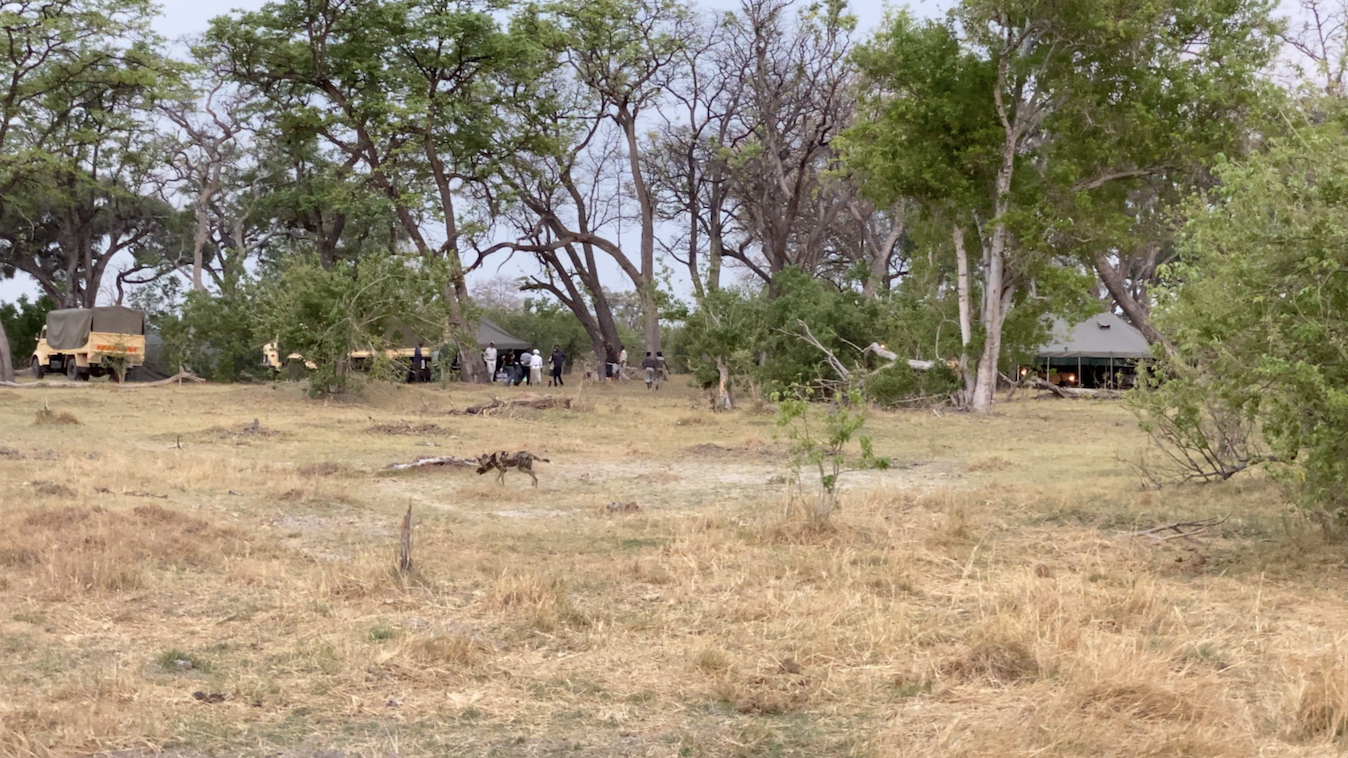
All the Brave Africa staff came out to watch the wild dogs hunt. You can see our main “mess” tent on the far right with our staff tents and moving vehicles on the left.
For some of our Brave Africa staff, it was the first time they’d ever seen a pack of wild dogs. While they’re out in the bush regularly, they mostly stay at camp. This means they’ve all seen elephants and various antelope, but predators are always rare, and they’re especially rare if you remain at camp and don’t go looking for them.
This time, the staff didn’t have to go on a game drive to experience something that is incredibly rare and exciting. All they had to do is stand at the edge of camp and watch. It was thrilling, and something we’ll be talking about for years.
Watch the wild dogs hunt for yourself!
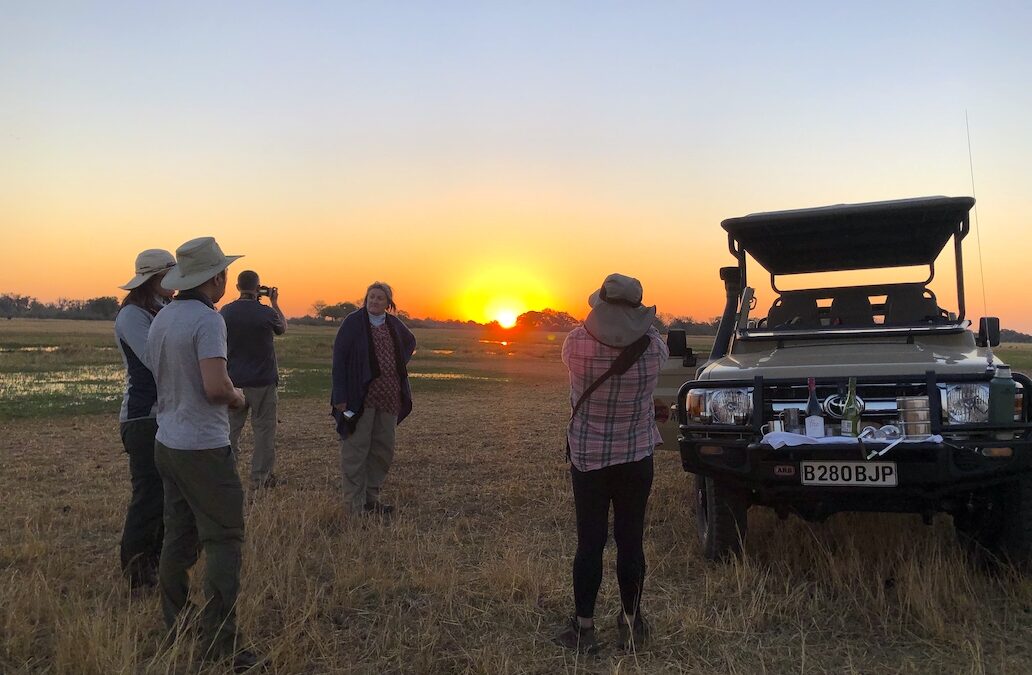
Oct 19, 2019 | Adventure Safari, Brave Africa Safari, Conservation, Most Popular Blogs
Before you decide where to go on your African safari, check out our ten reasons to go on safari in Botswana. We know you’ll love the Okavango Delta, Kalahari Desert, and Chobe National Park. Because if you’re looking for a safari that offers:
- 130,000 elephants
- Fewer crowds
- Conservation-focused tourism
- Incredible scenery
- 3,000 lions
- An adventurous experience
- Remote locations
- LGBTQ+ friendly policies
- Friendly people
- The best safari location in Africa
Look no further than Botswana! It’s truly a one-of-a-kind destination that everyone should experience.
1. 130,000 Elephants – The most of any African country
Botswana is known as “The Land of the Giants.” The country boasts 130,000 elephants, almost double the number of elephants you’ll find anywhere else in the world. This makes Botswana a haven and last refuge for these majestic creatures for the last 15 years.
What this means is that when you go on safari in Botswana, you’re almost guaranteed to see elephants every single day, multiple times a day. In fact, on our most recent trip out, we rarely had lunch without a few elephants stopping at a nearby watering hole to drink while we ate. Elephants roamed near our camp, came directly up to our safari car, and were almost everywhere we looked.
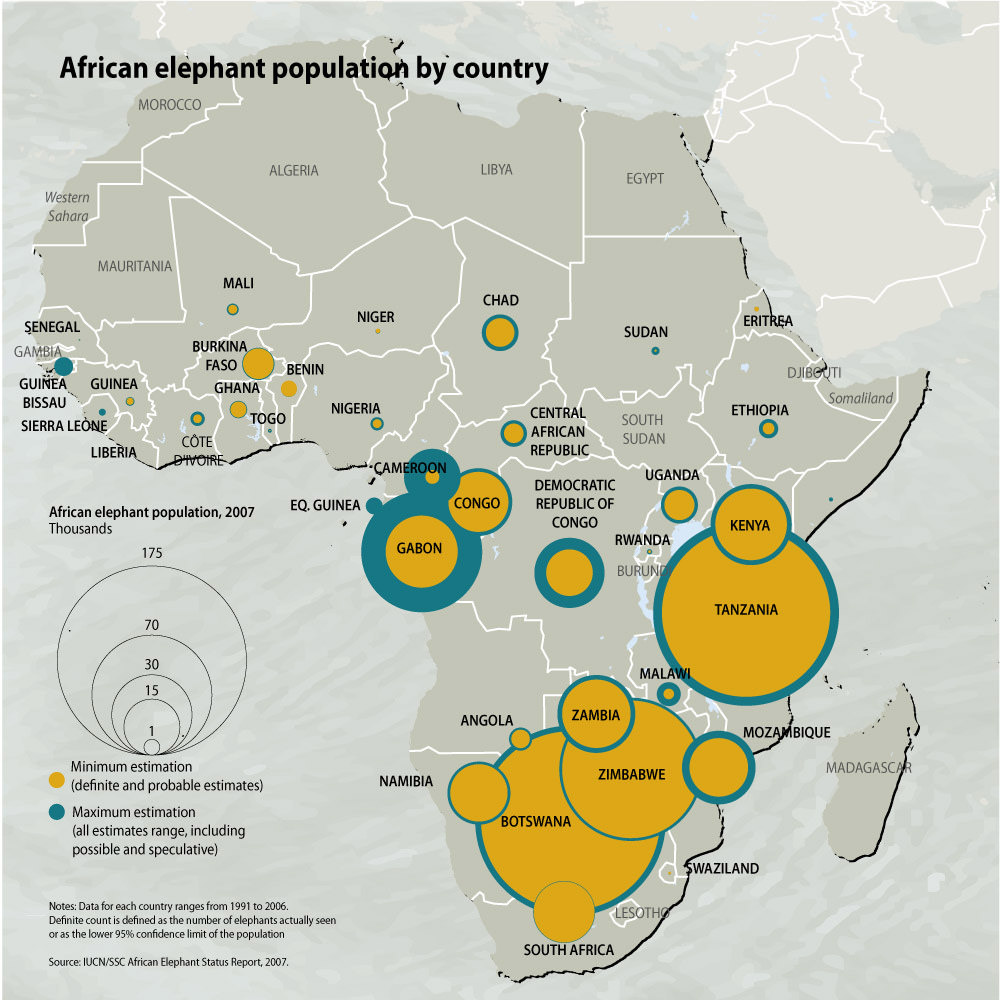
Botswana has the highest concentration of elephants by far.
2. Fewer Crowds — The experience is focused on quality, not quantity
The last thing you want when you go on safari is to be surrounded by crowds of people. After all, you’re heading to Africa to see the wildlife, not more tourists.
Botswana is considered the “road less traveled.” Fewer people think about Botswana when they consider locations for their African safari, and so there are far fewer tourists. For example, in Kenya’s Masai Mara, there are 7,000 beds available for tourists. In Botswana’s Linyanti Reserve (just outside of Savuti), there are only 58 beds in the same size area.
Botswana also has legislation in place that limits the number of tourists that can be in any single area. You won’t find as many tourists on safari in Botswana’s Okavango Delta, Chobe National Park, or the Kalahari Desert, and the camps are kept small. Most camps, including Brave Africa, max out at six tents, 12 guests. We also max out our safari vehicles at just six guests, so that every row has only two people and no middle seat.
The idea of Botswana is to have fewer crowds and more animal encounters. And isn’t that what you want?
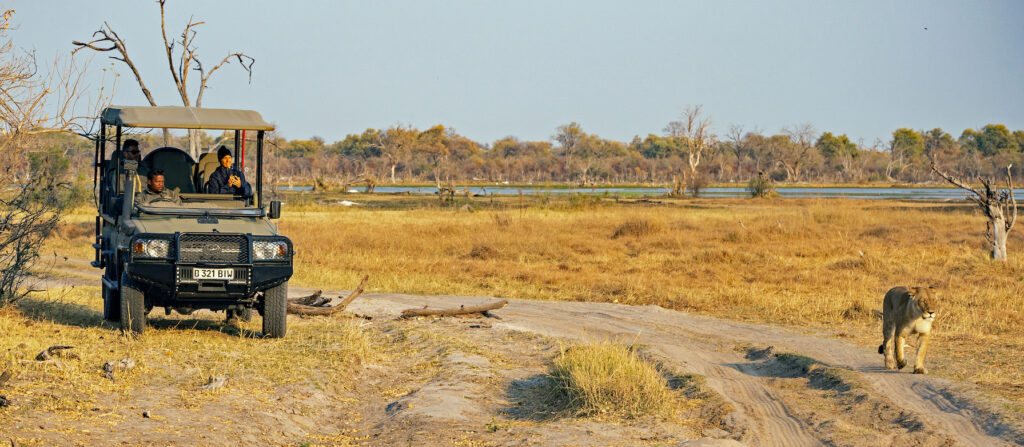
3. Conservation Focused — Botswana is ranked #1 in the world for conservation
Botswana is considered one of the last sanctuaries in Africa with untouched wilderness, making it a haven for endangered species. More than 25% of Botswana’s land area has been set aside for parks and reserves, dedicated to protecting the stunning landscapes and wildlife.
In 2017, the Lonely Planet ranked Botswana the #1 country in the world for conservation, saying, “they keep visitor numbers deliberately lower than they could so that they can manage the environmental impact of wilderness tours.”
For example, let’s take a look at rhinos. In 2001, Botswana had no rhinos left, so the country passed serious legislation focused on combatting poachers and protecting wildlife. Poaching in Botswana was punishable by death for a few years, and they are the only country to deploy the national military to keep poachers out. Today, around 400 rhinos have been reintroduced to the Okavango Delta.
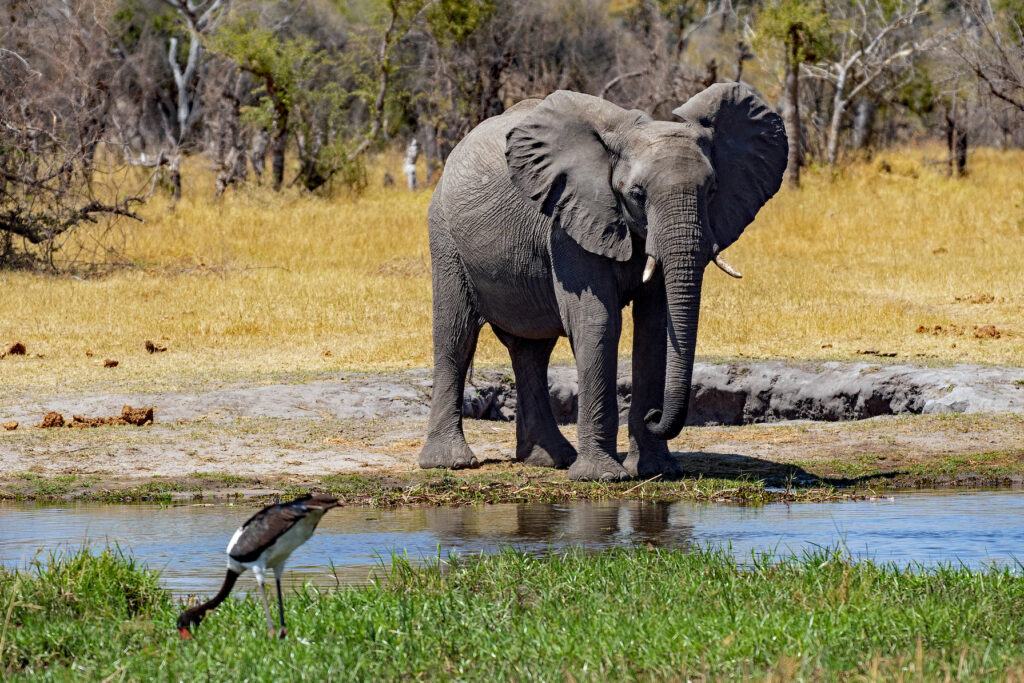
4. Incredible Scenery — Varied and stunning landscapes in the Okavango Delta, Kalahari Desert, and Chobe
Botswana is home to some of the most pristine and stunning landscapes in all of Africa. You can find a little bit of everything in the country from dusty red deserts to lush swamplands, sweeping floodplains, expansive savannahs, and vibrant forests. Honestly, during one all-day game drive, you can travel through a complete range of raw, rugged, and stunning landscapes.
In particular, the magical Okavango Delta stands out as Botswana’s main draw. It’s 16,000- square kilometers of wilderness with some of the densest wildlife in the world. The area is considered one of the largest inland water systems on the planet and home to one of Africa’s most diverse and vibrant ecosystems.
It’s a dazzling area with an abundance of lions, wild dogs, leopards, hippos, elephants, giraffe, kudu, and more. Then, there’s the Kalahari Desert that extends 900,000 square kilometers and covers much of Botswana. A semi-desert, it offers vast tracts of land that are excellent for grazing after good rains. This area is home to black-manned lions, oryx gazelle, and the incredible flamingo migration in Makagadikgadi Pans.
5. 3,000 Lions — Second only to Tanzania in lion populations
Lions can also be found throughout Botswana. In fact, after Tanzania, Botswana claims the largest population of lions in Africa. They thrive throughout the Okavango Delta, Central Kalahari, and Savuti. Best yet, lions in Botswana have some unique distinctions.
The Kalahari Desert is the only place in the world where you can see black-manned lions. These lions are known for their massive size and beautiful manes. Beyond their stunning manes, they also tend to have higher levels of testosterone, a better chance of survival, and a healthier disposition.
Then, in Savuti, there’s a pride of lions known as elephant killers. This incredible pride has learned how to take down adult elephants. While it’s not something you particularly want to witness, it makes the Savuti lions stand out for their unique hunting habits.
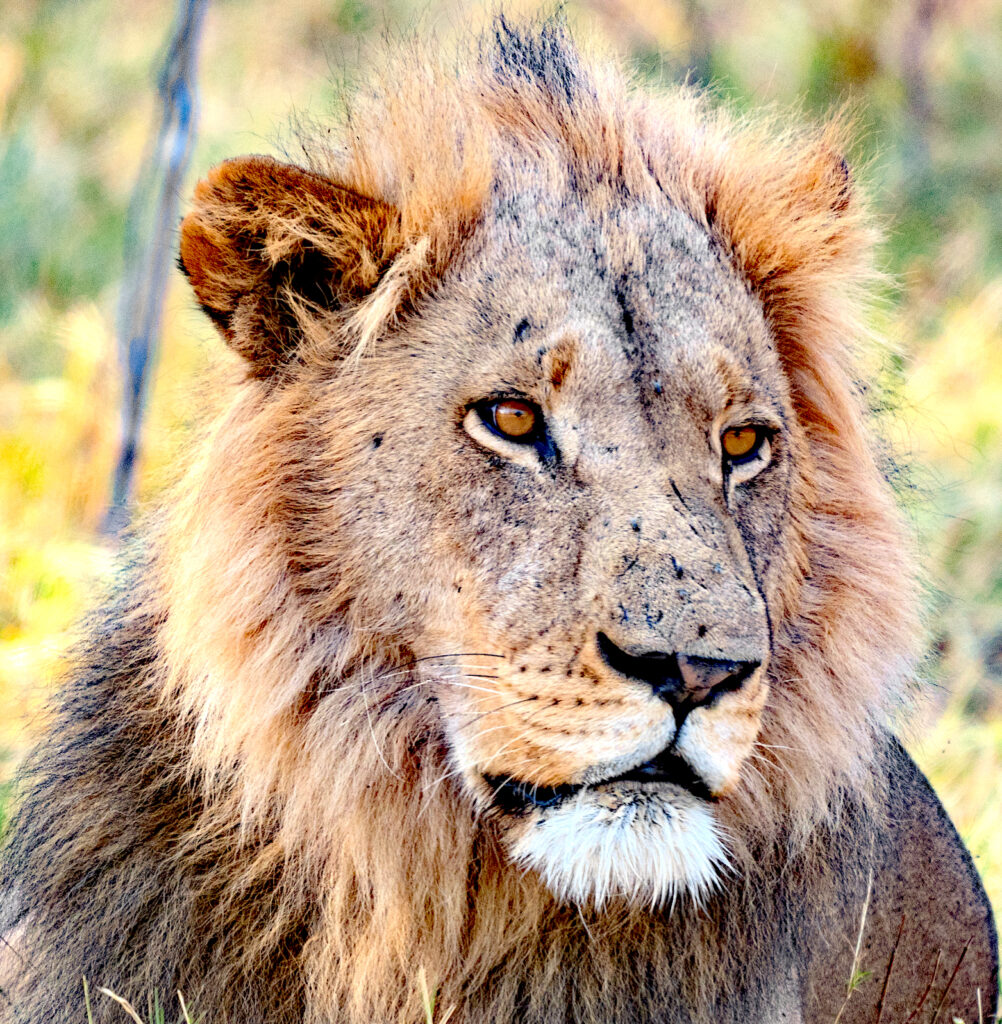
6. Adventurous Experience — Harkens back to the original safari experience
Since there are fewer tourists in Botswana, it creates a more intimate safari experience. It also translates into a much more adventurous safari that harkens back to the old days when Africa was relatively untouched by the rest of the world.
When you go on Safari in South Africa, Kenya, or Tanzania, you’ll notice that the animals tend to be very tame. Just search for videos on YouTube of cheetahs jumping on cars or a herd of zebra walking right near a car. There are so many tourists funneled through these destinations every year that the animals are desensitized. You might as well be at a zoo for all the attention the wildlife will pay to you.
That’s not the case in Botswana. Many animals in Botswana’s Okavango Delta and Kalahari Desert are still skittish around cars and people, which makes for a very different experience. It truly feels like you’re in the middle of the African Bush searching for incredible animals. Every day is an adventure, wondering what you’ll find and encounter. And because the animals are less used to humans, you always feel privileged when you have a fantastic sighting.
For example, we ran into a cheetah on our last time out that clearly did not recognize the sound of vehicles. As soon as it heard our engine, it took the cautious approach and disappeared. And while it was disappointing not to have more time with the cheetah, it was incredible to think that we may have been some of the first people to ever see him.
When you go on safari in Botswana, you feel more like an explorer, braving uncharted territory. And you feel grateful and proud of every perfect picture captured, and experience enjoyed.
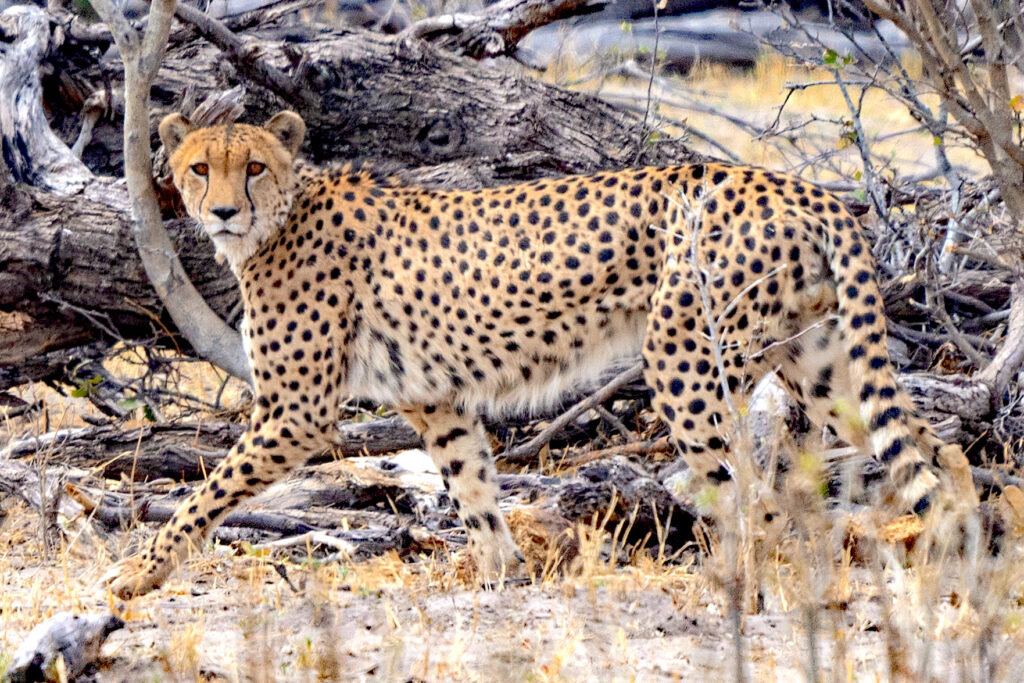
7. Remote Safari Destinations — Bush planes are required to go on safari in Botswana
Part of the adventure experience in Botswana is getting to your camp. While you’ll drive most places in South Africa, Kenya, and Tanzania, Botswana requires bush planes. The Okavango Delta is massive and can swell to three times its permanent size in the rainy season. This means that driving to your remote camp isn’t feasible. Instead, you have to fly into dirt airstrips.
We think this remoteness is what makes Botswana so incredible. There are no roads near your camp, just dirt paths. A Botswana safari is truly an exclusive and immersive experience where it’s all about the wilderness.
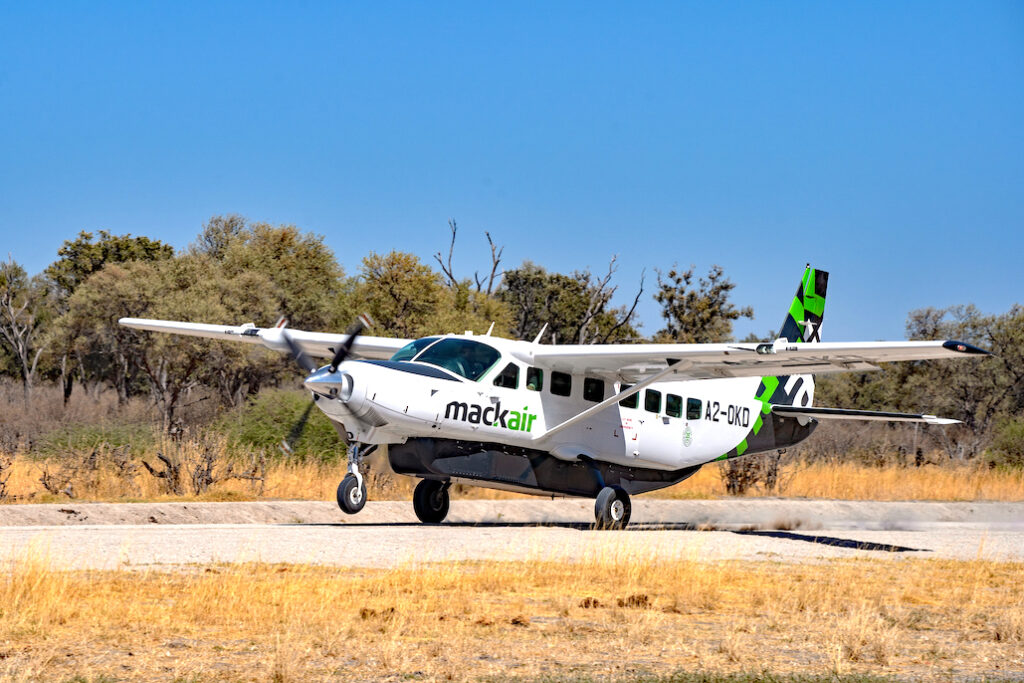
8. LGBTQ Friendly —Tolerance is promoted, and same-sex relationships are legal
This year, Botswana’s High Court unanimously voted to overturn laws that criminalize homosexuality. It was a momentous win for the LGBTQ+ community in Botswana and reflects the values of Botswana’s society.
During the ruling, Judge Michael Leburu admitted that the current laws were “discriminatory” to the LGBTQ community and violated Botswana’s constitution. He argued that overturning them was a matter of “protecting human rights.”
Botswana is actually one of Africa’s most stable democracies. In 2010, they changed their employment act to prevent discrimination against the LGBTQ community. And in 2017, the High Court ruled in favor of a transgender man who sought legal recognition as a male. 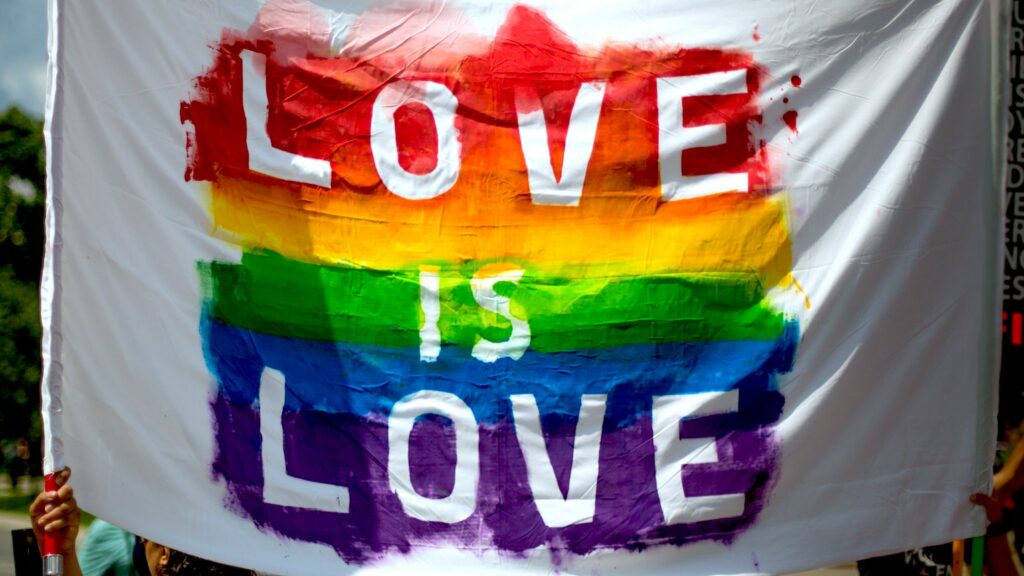
9. Friendly People —Botswanans are some of the nicest people you’ll meet
Botswana might be one of the least densely populated countries in the world, with a population of just over 2 million, but its people are the best. Botswanans are some of the friendliest and most accommodating people that you’ll meet. They take great pride in their country and in giving their best in everything they do.
You’ll be welcomed into Botswana with warm smiles and open hearts. Culturally, singing is incredibly important, so you’ll likely enjoy a song or two during your visit. You might even get to enjoy a few ululations on behalf of Botswanan women, as they show their excitement and happiness.
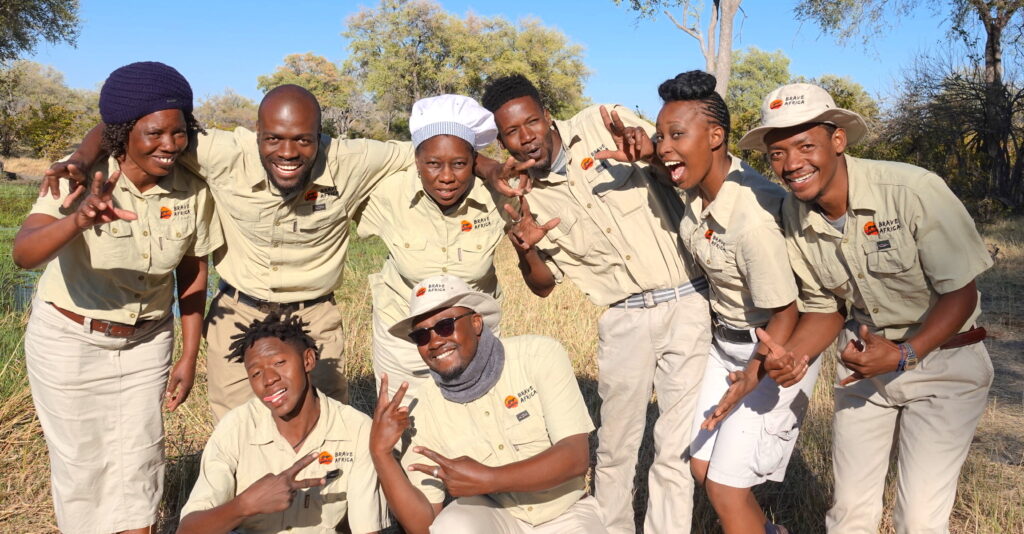
10. Best Safari Location — Botswana is regularly ranked as one of the best safari destinations
Chobe National Park is ranked as the #3 best safari destination in Africa by Fodors. It earns this prestigious title because of its incredibly dense game concentration. The area is “teeming with wildlife year-round,” Fodors writes. They also call Chobe a “stronghold of endangered species such as wild dog, cheetah, and brown hyena.” In particular, they recommend the Savuti Marsh, which we visit on our safaris.
CNN Travel recently put Botswana’s Kalahari Desert on its list of the eight best safari destinations in Africa. They write, “the Kalahari Desert represents Africa at its most brutally wild.” They highlight it as a “land of pure adventure” where you can gain insight into the diversity of Africa. They state, “there’s nothing better than a two-stop safari combining the shimmering pans of the Kalahari with Okavango wetland wilderness.”
Botswana also shows up on CNN Traveler’s “Most Beautiful Countries in the World” list. They talk about the Okavango Delta, calling it a “real-world Eden, where cheetahs, zebras, buffalo, and rhinos roam freely.”
According to Conde Nast Traveler, “Your First Safari Should Be in Botswana.” The article talks about the country’s unique tourism model that focuses on fewer people, but high spenders, so the economy grows, and there’s as little impact on the environment as possible.
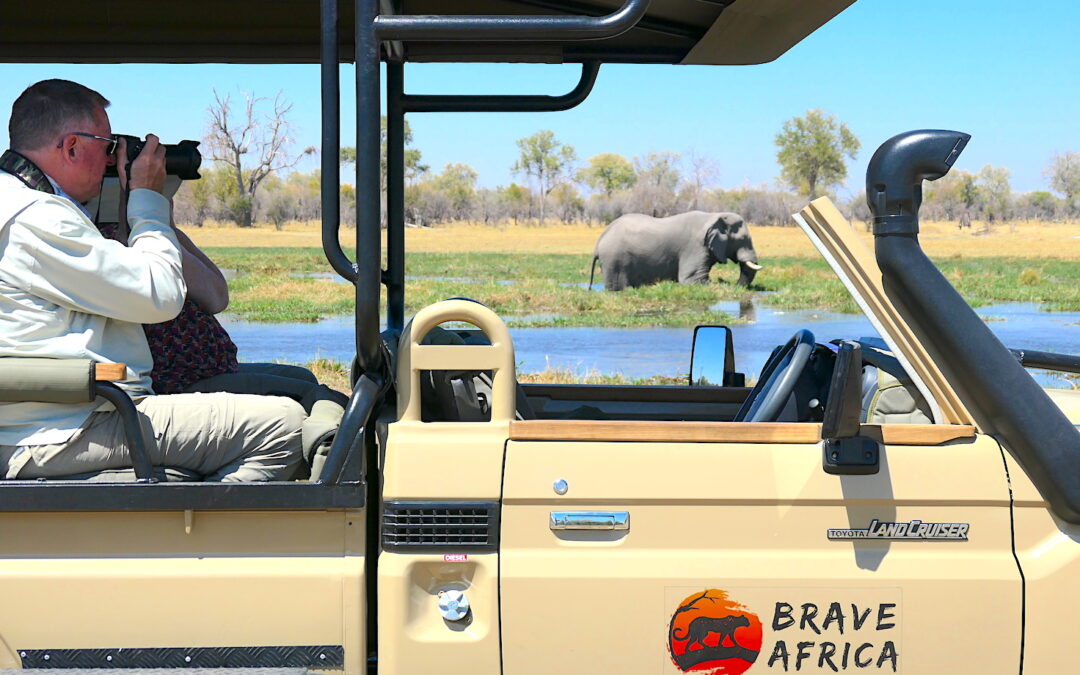
Oct 12, 2019 | Brave Africa Safari, Safari Tips
When planning an African adventure, there are a thousand questions you can and should ask yourselves. But we’re here today to talk about a subject that’s often overlooked by safari-goers. Whether it’s your first time on an African adventure or your tenth, before you choose your Africa safari camp or lodge, ask about your safari vehicle.
The Importance of Your Safari Car
Your safari vehicle could make or break your trip. You’ll be in this car day in and day out for hours upon hours at a time. It will be how you get through the thick and wild Bush, and it will be responsible for taking you to the animals.
You might be surprised to learn that every Africa safari camp and lodge uses different vehicles. Sometimes it’s because they want to offer a special experience for their guests, and other times the differences are just about saving costs.
Choosing a company that uses a crappy safari car will leave you feeling vastly disappointed and jealous of every other safari vehicle you see. But if you’ve never been on safari before, how do you know what’s a good safari vehicle and what’s not?
6 Features You Want in Your Safari Vehicle
At Brave Africa, we have top of the line safari vehicles, and we think the experience is well worth it, but don’t take our word for it.
Let’s dive down into the type of experience you want on your African adventure and the kind of safari car you need to make it happen.
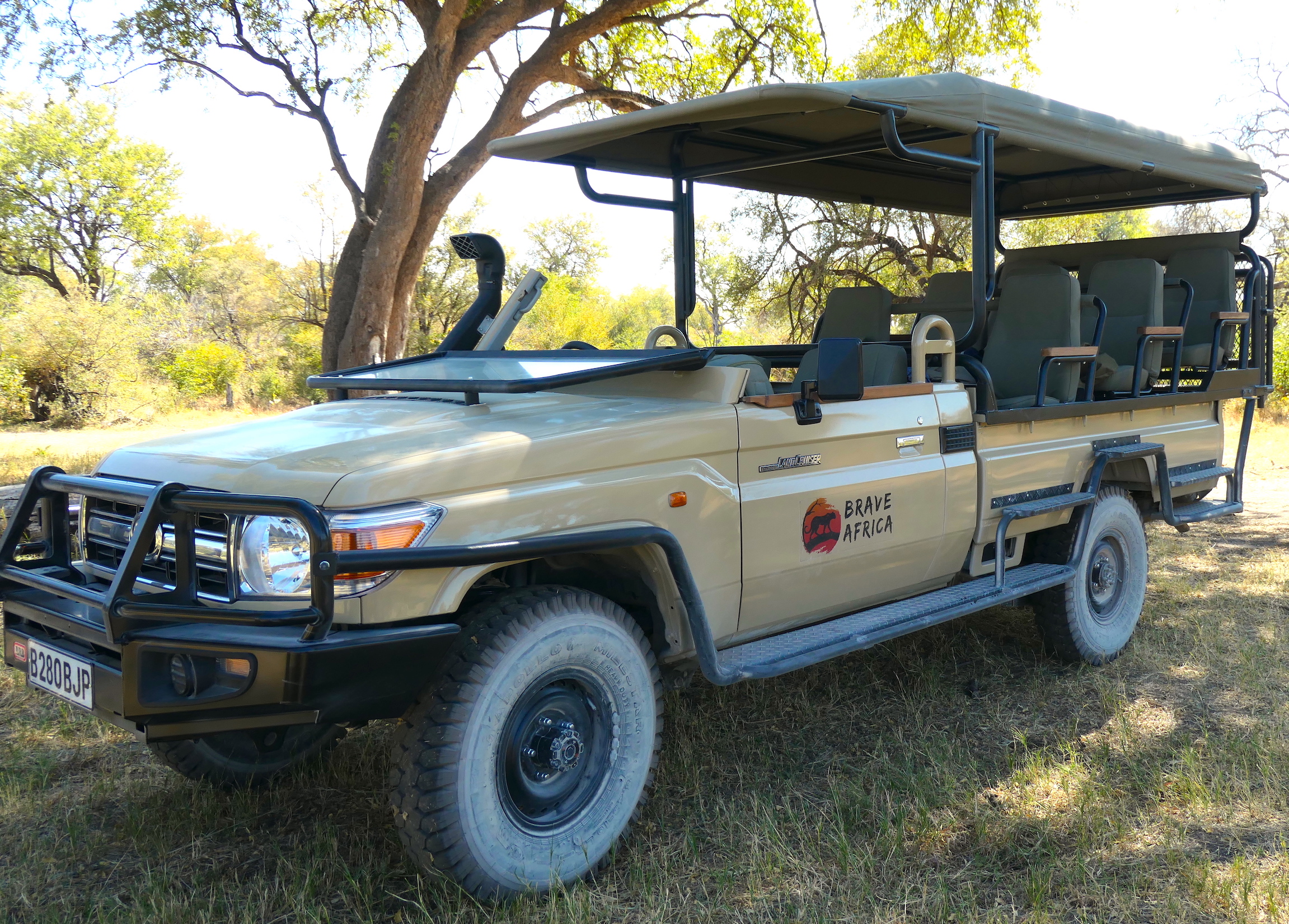
Every Brave Africa safari is custom-built to handle the Botswana Bush. The stadium-style seats in the back are open to the environment but still protected by a canopy from the sun and rain. There’s a snorkel that allows us to go through deep water, custom tires/wheels, a fold-down windshield, USB charging ports, a storage cooler, and more.
1. Toyota Land Cruiser
Twenty-five years ago, the Land Rover was the standard safari vehicle. But as soon as the Toyota Land Cruiser entered the market, it became the new Toyota safari truck, and the game changed forever.
Toyota Land Cruisers are incredible vehicles that can handle the muddiest of conditions without getting stuck. It’s a powerful and dependable vehicle that’s known for exceptional performance, reliability, and durability. It offers a smooth ride even in the toughest of conditions, and it can go for days on a single tank of diesel, of which the safari car has two.
However, an off-the-shelf factory Toyota Land Cruiser isn’t precisely what you’re looking for either. It should be specially modified for safari conditions. These modifications include:
- A snorkel that can handle deep water
- Updated shock and suspension system for a smoother ride
- Increased ground clearance
- Updated wheels and tires specifically designed to handle the African Bush
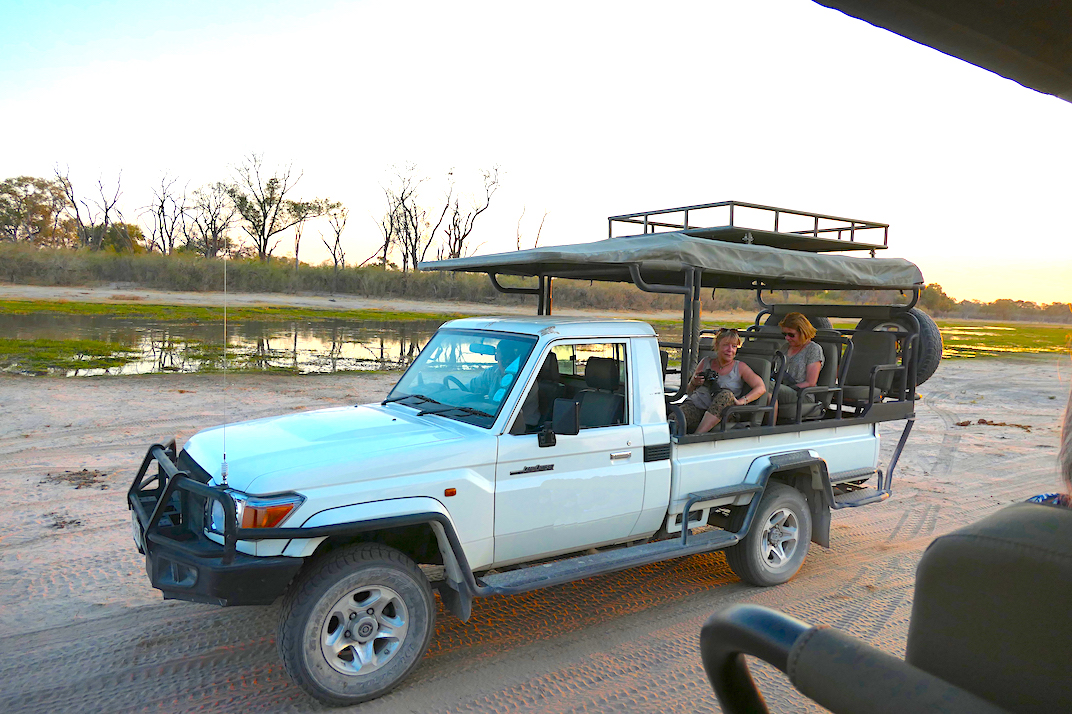
Notice the lack of modifications on this safari vehicle. There is no snorkel, which means deep water will be an issue. There also looks to be little to no modifications when it comes to the wheels/tires, the cab, and more. It’s basically a pickup truck with seating placed on the back.
2. Fully Open Vehicle
If you’ve done any safari research, you’ve probably seen tons of images of different types of vehicles. In Kenya and Tanzania, most safari camps and lodges prefer fully enclosed safari cars where you have to stand up for a clear view of the wildlife without windows.
However, in Southern Africa, including Botswana, you’re mostly going to find safari vehicles with a more open-air approach, but how open it is can drastically change your African adventure.
Open Seating in Your Safari Vehicle
First, let’s talk about your seating area. There are completely open safari vehicles—no windows, doors, or frames blocking your view. Then, some vehicles claim to “protect you from the elements” while at the same time changing how you experience the Bush.
How much access you want to the animals is up to you, but we think the more open, the better. We feel that having something between you and the animals takes away from the magic of your African Adventures. It transforms your experience into something more zoo-like and less “in your face” majesty.
A closed seating area will mean that you’ll deal with less dust, but we think that’s part of the safari experience. We’d rather breathe in a little dust and maybe get wet, but be right there ready and waiting to watch a lion walk by our car or hear an elephant trumpet at us.
However, no matter how open the car is, it’s the seating that matters too. You do not want to be in a car with middle seats. Ask your safari operator how many people they’ll allow per car. We max out at six occupants so that everyone has a window seat, and no one is stuck with a lousy view.
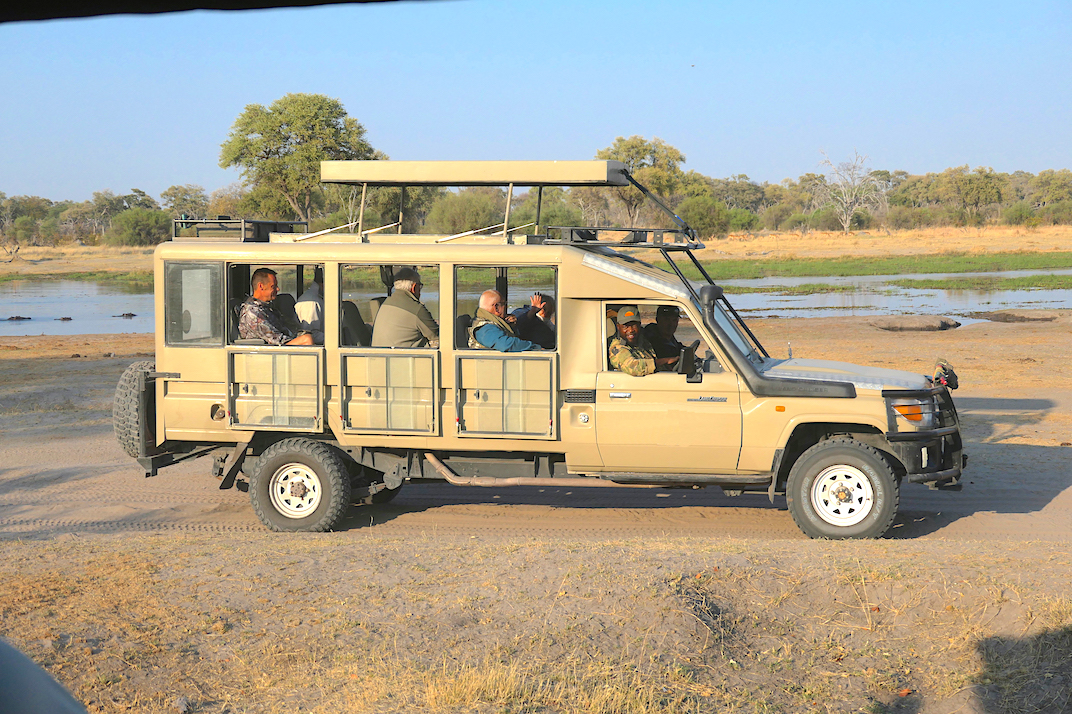
This safari vehicle offers a closed off seating area, which means an obstructed view of the wildlife as well as a hot backseat experience. More likely than not, there’s no air conditioning in the back, and with a closed-off front cab, very little chance for a breeze. That’s tough. And when it comes to birding, this car will not be helpful.
Open Cab Safari Car
Second, let’s talk about the driver’s cab. Even in safari cars where the entire seating area is open to the elements, you might find a situation where the cab is closed. This is definitely something you DO NOT want.
A closed cab means you are closed off from your safari guide. Yes, he or she might still be able to talk to you by leaning out the window, but it’s going to be ten times harder to interact with them, which will greatly detract from your experience.
Your safari guide is essential to your time in the Bush. They’ll explain animal behavior, unique plants, and more. Think of it like being in the car with a live Wikipedia page that can answer all your questions on the spot without the Internet.
Now, imagine that to get to your Wiki page, you had to click ten different buttons to find the answer you wanted. That would get annoying quickly, right? That’s the same with a closed cab. If you don’t have direct and easy access to your guide, you won’t be able to hear what he or she has to tell you throughout your drive, and you’ll lose out on an incredible amount of insight.
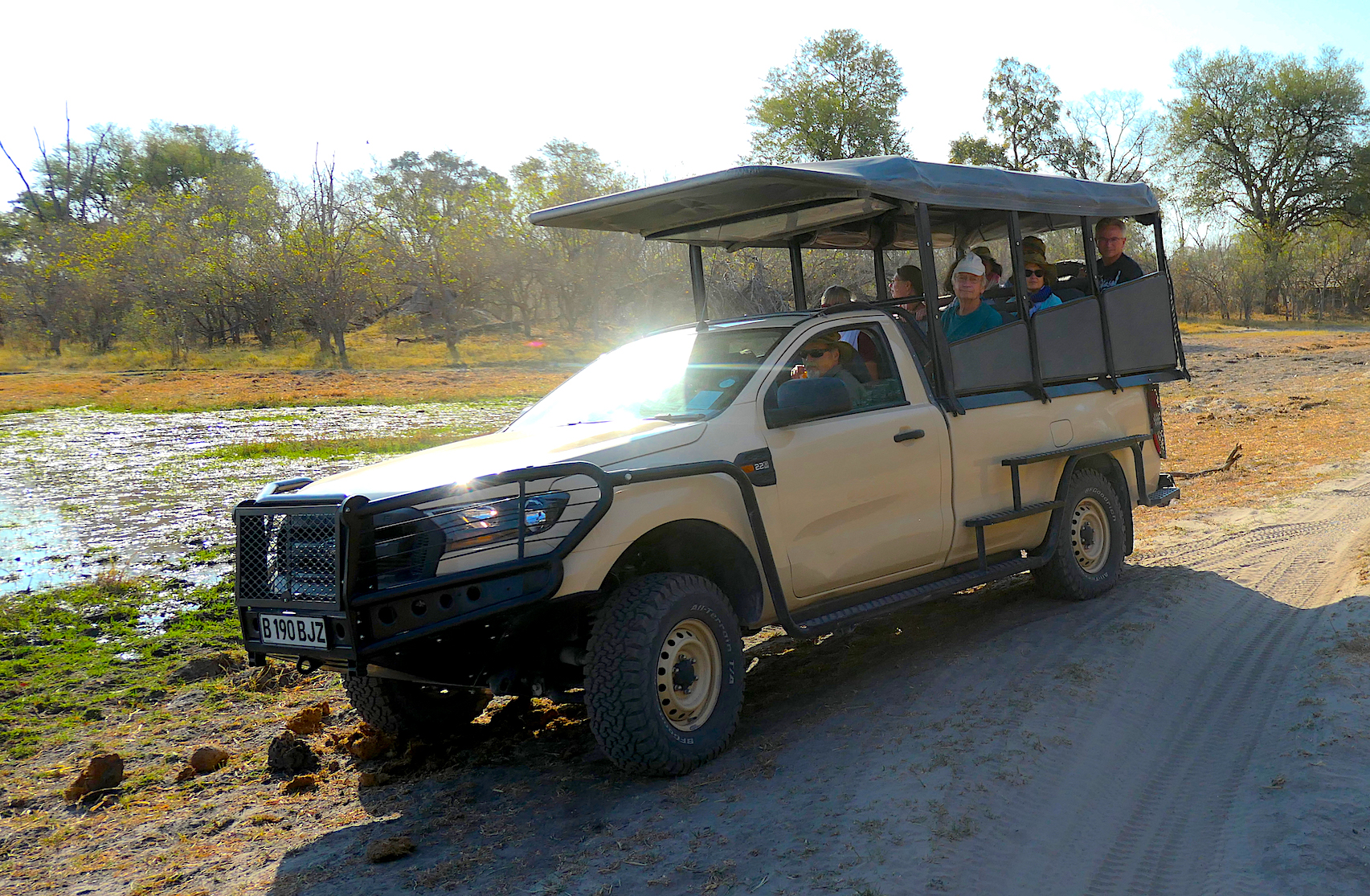
This safari vehicle has a closed cab, which makes it difficult for guests to talk with their guide for a far less personal experience. It also has a very closed in seating area. Those guests in the back row have very limited viewing. Also, notice the middle seat…that’s a lot of guests in one vehicle.
3. Canopy Cover
Now, a fully open vehicle is excellent, except when you don’t have a canopy! Yes, Botswana might be a desert, but that doesn’t mean it won’t ever rain, and when it rains, you want a canopy to keep you from getting soaked. But even when it doesn’t rain, a canopy is fairly essential.
The sun is hot and in Botswana—with an average of 3,300 hours of sunshine every year—and that means you want to be in the shade as much as possible. A fully open cab without even a canopy will mean you have no protection from the elements.
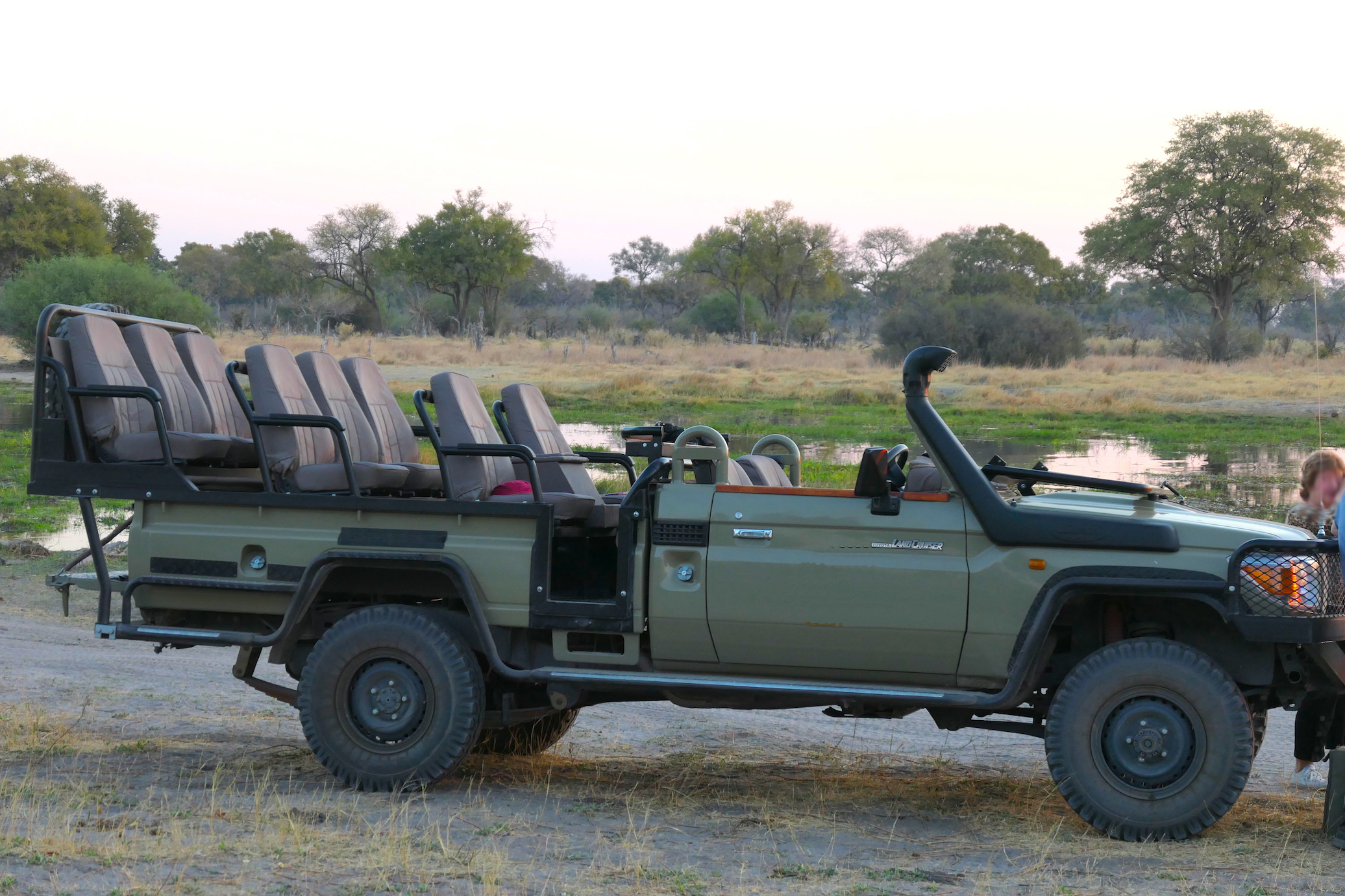
Without a canopy, guests in this vehicle will have no relief from the sun or rain.
4. Safari Car Power Charging
Access to power is critical even in the middle of the Bush. Between our guests’ cameras, phones, and other technology, we know that having the ability to charge your devices is essential to an enjoyable experience. And with 12- to 13-hour game drives, relying on only battery power can be nerve-wracking.
That’s why every Brave Africa safari vehicle offers two USB charging stations at each seat, so you can charge two items at once throughout your daily game drives. You’ll never have to worry about going without power.
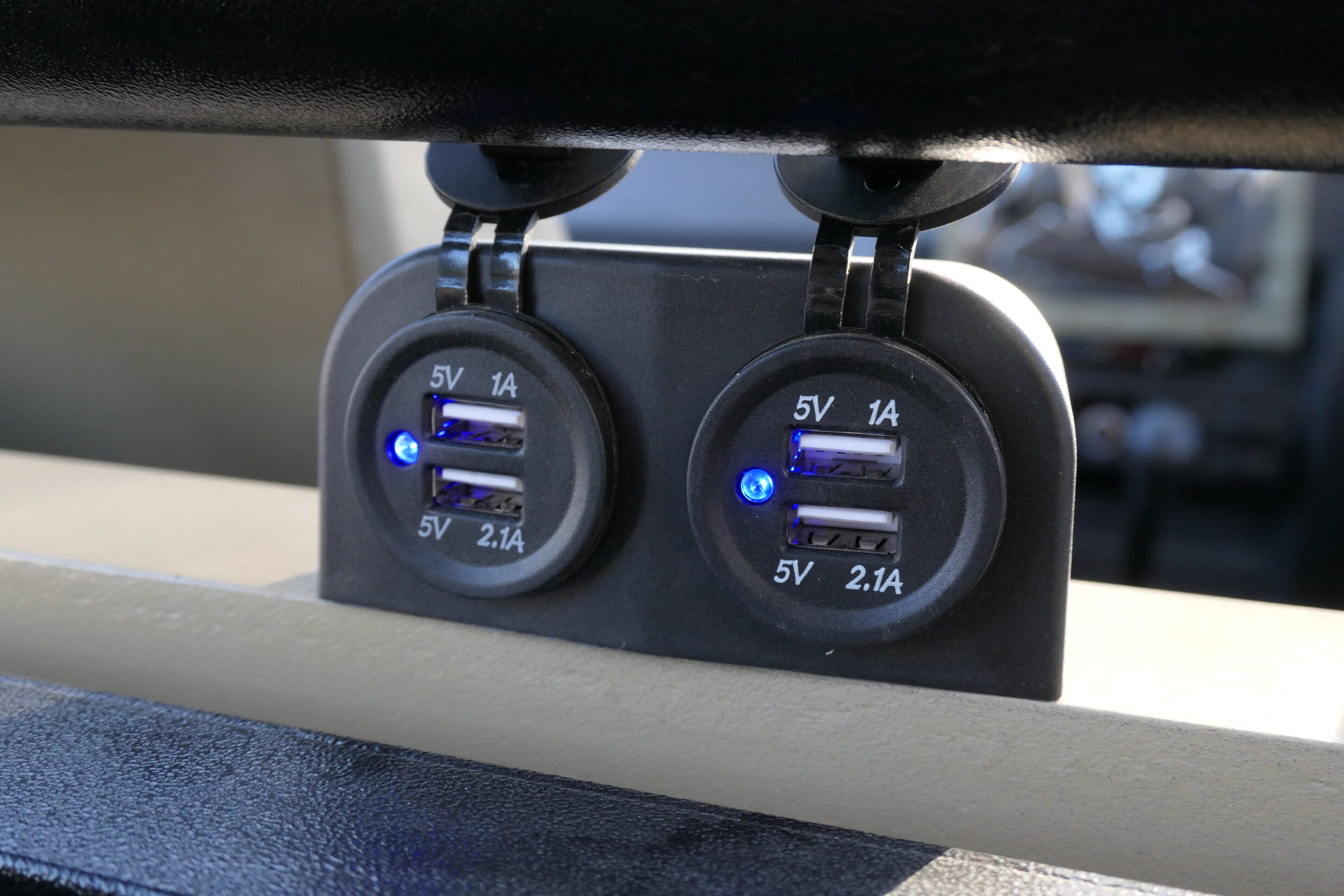
Every Brave Africa safari vehicle offers 2 USB ports per seat. Here’s a picture of the four slots for the two front seats.
5. Refrigerator System
When it’s 35 degrees Celsius (95F), it’s way too hot not to have access to ice-cold water, juice, soda, or beer to cool you down in the heat. So, before you choose your African adventure safari, ask the operator if they have a refrigerator system in their safari car.
In the middle of Brave Africa’s first row of passenger seats, we have a large refrigerator that can hold around two dozen cold drinks. This means that no matter how far away from camp you are, you can still enjoy crisp cold drinks on a blistering day.
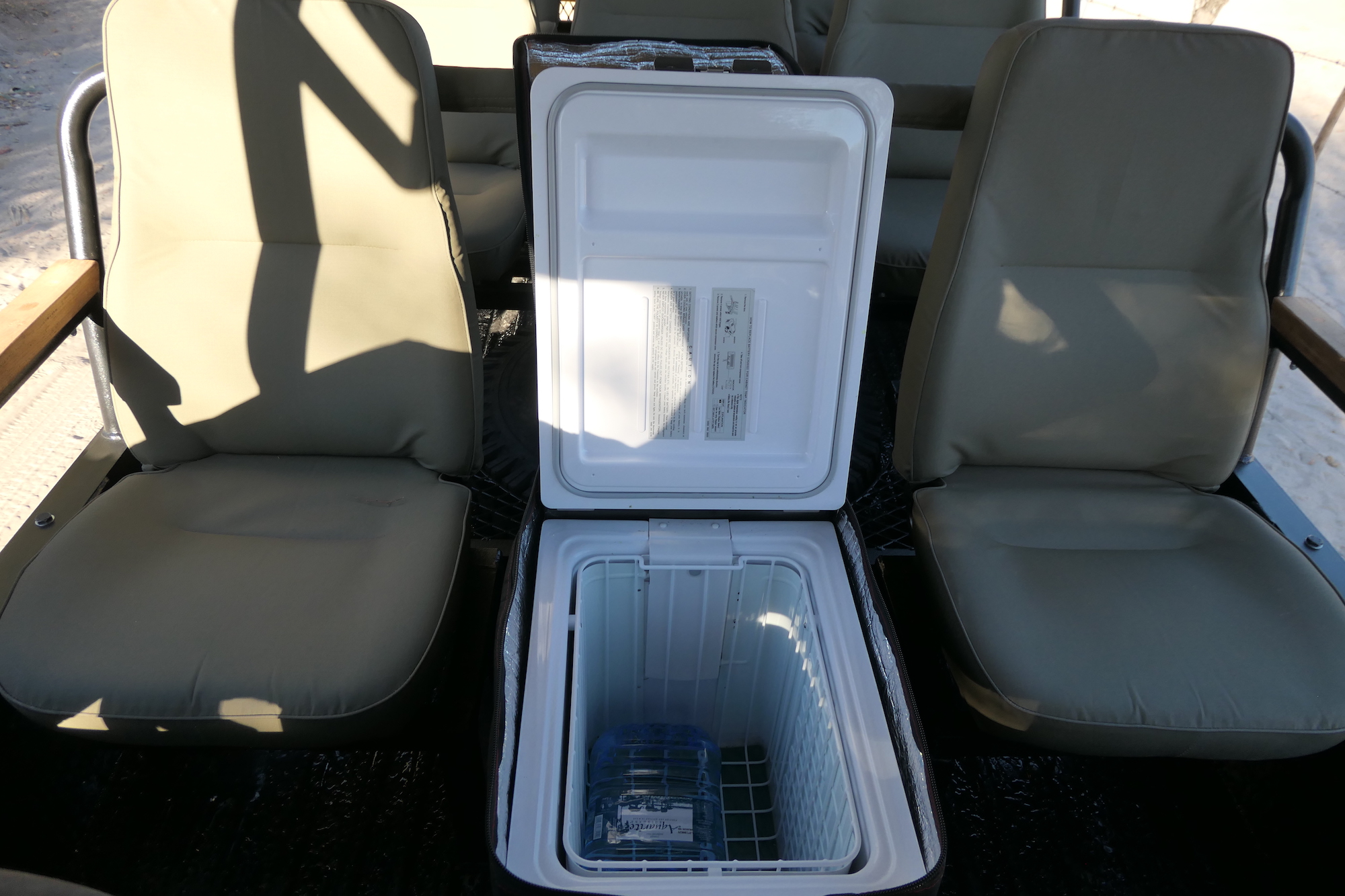
Between the first two seats, we added a cooler for ice-cold drinks and food on every game drive.
6. Storage Options
When you’re on all-day game drives, you need to be able to bring a lot of stuff with you to have a good experience, and that means you need storage space. You need room to store your day bag with your camera, phone, spare jacket, and other personal items. There also needs to be room for snacks, lunch, tables, chairs, and other items you might need on your all-day drive.
At Brave Africa, we max out our vehicle at six guests, so there’s plenty of room to leave your bag. In the back two rows, you can place your stuff in the middle seat. In the front row, you can put your items on top of the refrigerator. There’s also plenty of room to put your bag at your feet as needed.
As for storage for tables and chairs, we’ve built on an extra storage rack on the back of the vehicle. This rack can be folded down or up and used to store guest luggage to and from the airport. We also use it to carry tables and chairs for lunch in the Bush—a requirement for every African adventure.
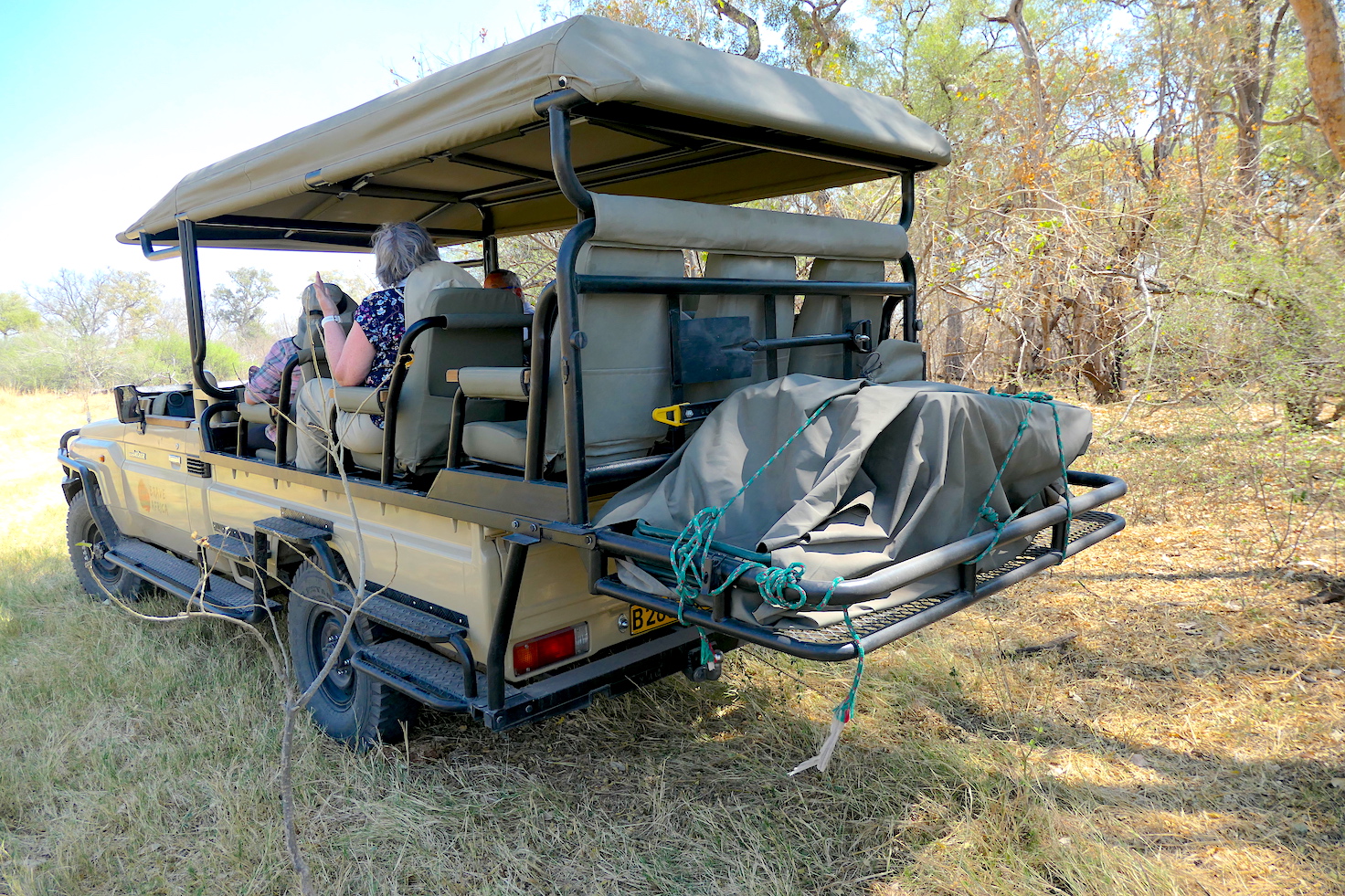
We built a custom storage rack onto the back of every Brave Africa safari vehicle. This rack can be used to store guest luggage, tables, chairs, and more.











































